
Hey there! I am Subiksha.
I studied Biotechnology and later transitioned into driving organic traffic for a B2B SaaS company. My journey began with an online plant nursery, which sparked my interest in content writing and SEO. I worked as a content writer before moving into a role focused on organic growth.
Feel free to reach out if you want to talk plants, SEO, or content!
%20(1).avif)
Lead Enrichment Explained: A B2B Marketer's Guide for 2025
In B2B marketing, every lead matters, but not all leads convert into customers. Only high-quality leads can turn into valuable customers. So, how do you identify the valuable prospects amid the junk? The answer is through Lead Enrichment.
A name in your CRM tells you little about whether a lead is worth pursuing. To qualify them for sales, you need more information, such as their company, job title, and location. The Lead Enrichment process bridges this gap. It turns these basic contact details into rich, actionable profiles. This process allows your sales team to target the right prospects with precision.
Keep reading to know how Lead Enrichment can enhance your sales process.
TL;DR
- Lead enrichment enhances basic lead information, such as email addresses, with valuable data, like company size, industry, revenue, and pain points.
- Lead enrichment enables marketers to prioritize leads, personalize outreach, and refine marketing strategies. By leveraging enriched data, marketers can segment audiences effectively, leading to targeted campaigns that resonate with ICP.
- Key types of lead enrichment data include contact details, firmographics, demographics, technographics, intent signals, and behavioral insights. These data provide a comprehensive view of leads and their interests.
What is Lead Enrichment?
Imagine you’ve just wrapped up a successful campaign and collected a list of email addresses. You now have a pool of potential customers, but there's a catch. Without more detailed information, engaging with them becomes a challenge. The solution? Lead Enrichment.
Lead enrichment provides valuable insights into key details like company size, industry, hierarchy, revenue, and the challenges they face. With this data, you can craft personalized messages that address their pain points by positioning your solutions as the perfect fit for their needs.
B2B Lead Enrichment, or data enrichment, involves gathering information about potential customers, such as contact and company data, using top B2B lead enrichment tools.
By understanding these leads with greater detail, you can determine your audience's interest level in the company's products or services. This process helps you improve sales and marketing efforts, ultimately increasing the conversion rate and Return on Investment (ROI).
Why is Lead Enrichment Important For B2B Businesses?
B2B businesses are highly competitive. Accurate and up-to-date data is essential to outlive the competition.
According to The State of CRM Data Management Study in 2023, 58% of respondents indicated data accuracy is still a significant problem.
This is a considerable gap.
With accurate data, marketing teams can efficiently qualify, and score leads, enabling them to drive predictable revenue. B2B lead data enrichment can help you:
- Assess lead fit and prioritize prospects by gaining deeper insights into potential customers.
- Leverage accurate data to personalize messaging and boost conversion rates.
- Build stronger customer relationships by addressing their needs and preferences.
Types of Lead Enrichment Data

Here are the types of lead enrichment data you need to scale your lead enrichment efforts:
1. Contact Data
Contact data, including the contact's phone number and email address, forms the foundation for effective prospecting and lead generation. Accurate contact data ensures you target your Ideal Customer Profile (ICP).
2. Firmographic Data
Imagine you are running a targeted marketing campaign for the IT industry based in the US. Then, firmographic data is what you need. This data is crucial to segmenting and targeting leads effectively.
Firmographics data includes:
- Geographic location
- Customer base
- Industry
- Revenue
- Company structure
3. Demographic Data
Demographic data helps you define and build your ICP. With demographic data, you can personalize your outreach, making it more relevant and engaging. Demographic data includes:
- Age
- Job title
- Gender
- Income
- Education
- Job role
4. Technographic Data
By understanding a company’s tech stack, you can assess if your solution is a good fit to solve their pain points. Technographic data gives you such insights. Technographic data includes:
- Hardware used by the target company
- Software used by the target company
- Applications used
- Account’s IT infrastructure
For example, if you know your ICP is using Hubspot CRM, you can tailor your pitch to highlight how your product integrates seamlessly with Hubspot.
5. Intent Data
Intent data tracks a potential customer's online behavior, such as interests, pain points, and readiness to buy. This allows you to focus on prospects actively searching for solutions like yours and reach out at the right time when they're most receptive to your message. Intent data includes:
- Web searches.
- Content consumption.
- Website/page visits.
- Interactions on the website
With tools like Factors, you can track buying signals by analyzing your leads’ visited website pages, LinkedIn ad campaigns, G2 data, and third-party sources like Gartner and TrustRadius. This helps you target the most promising leads and personalize your outreach for maximum impact.

6. Social Media Data
Social media data enrichment refers to using platforms like Facebook, Twitter, or LinkedIn to gather insights. By tracking your leads’ online behavior, you can uncover their interests, connections, and engagement patterns. This data allows you to personalize your messaging and target your ICP on social platforms.
For instance, you can personalize the message and target the ICP through LinkedIn ads for running ABM campaigns.
7. Behavioral Data
Behavioral data pinpoints prospects who are actively engaging with your content. It gives insight into their online journey, revealing interactions, actions, and engagement patterns. Key behavioral data includes:
- Email engagement, like open rates, click-through rates, and reply rates
- Website activity like page views, time on site, and bounce rates
- Content consumption, including downloads, shares, and comments
- Event Registrations, attendance, and engagement levels
- Site Navigation
- Purchase history
8. Account Data
Account data provides a comprehensive overview of the entire organization, not just an individual lead. This information is crucial for B2B companies to identify cross-selling and upselling opportunities. Essential account data includes:
- Company size and revenue
- Industry size and vertical
- Company hierarchy, including subsidiaries and parent company.
9. Geographic Data
Geographic data provides customer location. By understanding where your leads are based, you can tailor sales and marketing efforts to specific regions. It includes:
- Country
- State
- City/Town
Location-based data helps you run localized campaigns and optimize marketing spend by targeting regions with maximum potential.
Don't miss our B2B account scoring guide for additional details.
How Does Lead Enrichment Work?
The lead enrichment process involves key steps like data collection, lead scoring and segmentation, lead routing, lead conversion and nurturing.

1. Data Collection
This step involves collecting lead information from various sources, such as in-house databases and third-party providers. You can also purchase high-quality data from reputable B2B data providers and add information such as company size, industry, job titles, and contact details.
2. Lead Scoring and Segmentation
Evaluate leads based on their perceived value and potential for conversion. Group leads into categories based on their shared characteristics allows you to tailor your outreach and increase effectiveness.
3. Lead Routing
Assign leads to sales representatives according to their expertise and territory. Lead routing software can help you streamline the process, ensuring that leads are distributed efficiently and to the right person.
4. Lead Conversion and Nurturing
Refine your lead scoring criteria to identify high-quality prospects. Tailor messaging to address each lead's unique needs and interests. For leads that haven't converted yet, maintain engagement with personalized follow-ups and relevant content to nurture the relationship.
Use Cases For Lead Enrichment
The key use cases for B2B lead enrichment include:
1. Targeted ABM
Identify your ICP and tailor your messaging to address the specific challenges faced by each of your target accounts.
2. Data-Driven Lead Scoring
Assess the lead quality based on enriched data. Focus your time and effort on the most promising prospects with the highest potential for conversion.
3. Enhanced Customer Segmentation
Create targeted campaigns based on factors such as industry, company size, and other firmographic attributes. This approach helps you meet the unique needs of different customer segments.
4. Data-Driven Marketing Automation
Automate marketing efforts based on specific lead behaviors and attributes to move them through the sales funnel more efficiently.
How can Factors Help with B2B Lead Enrichment?
One of the biggest challenges B2B marketers face is dealing with anonymous website traffic and the absence of clear buying signals. Without understanding who is visiting your site or what stage of the buyer’s journey they’re in, it’s difficult to nurture and convert leads effectively.
Here’s how Factors can help in the lead enrichment process.
1. Unify Cross-Channel Intent Signals
Factors combines intent data from multiple sources such as website visits, G2, LinkedIn ads, and third-party platforms like Gartner and TrustRadius. It gives you a complete view of your prospects’ interests.
2. Identify High-Value Leads
Factors uncovers up to 64% of your anonymous website traffic, enabling you to focus on companies actively researching your solutions. It helps you prioritize leads with higher conversion potential.
3. Industry-leading match rates
The powerful reverse IP lookup technology of Factors app reveals firmographic and engagement data, enriching leads with key insights about your anonymous visitors.
You can easily integrate Factors with your existing tools, such as CRMs and ad platforms. The setup process is simple. By using Factors, you gain the data you need to target better and prioritize leads, and improve your B2B marketing efforts.
Check out how Rocketlane generated 23% more MQLs and boosted its pipeline with Factors.
Lead Enrichment: Filter Your High-Value Leads
Lead enrichment is a vital component of maximizing lead generation in B2B marketing.
By enriching your lead data with firmographic, demographic, and intent data, you can better understand your target audience and their needs. In this process, you identify high-value leads who are actively seeking solutions.
Lead enrichment enables you to run targeted campaigns that resonate with specific segments, ultimately improving conversion rates. It also allows you to assess potential customers' fit more accurately, ensuring your sales team focuses on the most promising leads and drives predictable revenue growth.
Enhancing lead data drives better targeting and engagement.
1. What It Adds: Key details like company size, industry, and contact info.
2. Why It Matters: Supports personalized messaging and campaign precision.
3. Strategic Benefits: Boosts sales effectiveness, improves segmentation, and increases conversion potential.
Lead enrichment equips teams with deeper insights to drive meaningful connections.
FAQs on Lead Enrichment
What are the benefits of lead enrichment?
Lead enrichment is essential to keeping the B2B lead data accurate and updated. The sales and marketing team can assess and prioritize qualified leads and create personalized messaging based on enriched data, which leads to higher engagement and conversion rates.
What is data enrichment in lead generation?
Data enrichment is the process of enhancing your existing lead data with additional information. It involves gathering data points on warm leads’ interests in your offerings to create more complete and accurate profiles of ICPs.
What is sales enrichment?
Sales enrichment is a specific type of lead enrichment that focuses on gathering and organizing information about potential customers, specifically for sales purposes. It includes contact details, job titles, company information, and purchasing history.

From Website Visitor to Warm Outbound Play: How to Use GTM Engineering Services for Intent-Driven Outreach
TL;DR
- Visitor ID + Intent Data = Real Pipeline: Identify ICP-fit companies visiting your site using reverse IP and intent filters, even if they don’t fill out a form.
- GTM Engineering Automates Everything: From enrichment to outbound handoff, custom workflows eliminate manual busywork and trigger timely outreach.
- Prioritization Drives Focus: Accounts are tiered by fit and intent, allowing reps to focus efforts where they matter most, not just on who clicks first.
- Human Touch, AI Assist: AI-generated summaries and contact bundles give reps the context they need to personalize without guesswork or delay.
Let’s be honest: traffic and MQLs don’t pay the bills. Pipeline and revenue do.
Here’s the truth: your best prospects are probably already on your website. They’re comparing features, peeking at pricing, and reading that one blog you’re weirdly proud of. But only ~3% of visitors fill out a form. The other 97%? Anonymous..unless you can identify the company, recognize buying intent, and trigger smart outreach automatically.
This article shows you how to do exactly that with website visitor identification, intent data, and a layer of GTM engineering that turns signals into ready-to-send outbound and, ultimately, qualified conversations.
We’ll keep it practical, human, and zero-fluff. (Coffee optional. Results, not.)
And yes, we’ll show how Factors does the heavy lifting, tooling, data, and workflows included.
TL;DR: This is the fastest way to build pipeline without ballooning ad budgets or headcount.
But first, the basics.
What is intent data?
Intent data is any signal that shows a buyer might be researching your category or solution. There are four types of intent data:
- Zero-party: They tell you directly (e.g., a demo form).
- First-party: You observe it on your assets (e.g., web sessions, page views, clicks).
- Second-party: Another company’s first-party data (e.g., G2 page visits, LinkedIn Ads views).
- Third-party: Aggregated across many sites (e.g., Bombora-type data).

Why it matters: Studies suggest buyers are ~57% through their journey before they talk to sales. You need to engage earlier, when intent shows up, not when a form arrives.
What is website visitor identification?
It’s how you de-anonymize company-level traffic on your site (without personal PII). Tools like Factors.ai use industry-leading reverse IP technology and enrichment to reveal who’s on your site (company, industry, size, tech, etc.) and what they’re doing (pages, sessions, engagement depth).
Factors.ai offers best-in-class coverage for website visitor identification. It identifies more than 75% of anonymous website visitors using sequential waterfall enrichment.
What is GTM engineering?
GTM engineering is the missing link between knowing who’s interested and acting on it in real time. It’s the setup of automated workflows (with AI where helpful) that connect your data sources, website, ad platforms, CRM, Apollo, Slack, and more, to trigger instant, contextual outbound plays.
With Factors’ GTM Engineering services, you don’t just get software; you get a managed system that:
- Detects intent signals in real time
- Identifies which companies are visiting your site
- Enriches contact data automatically via Clay and Apollo
- Scores and prioritizes accounts (AI-enabled predictive scoring included)
- Sends ready-to-act Slack alerts and email drafts to SDRs/Sales in minutes (not next Tuesday).
- Automate outreach via LinkedIn InMails, calls, and emails
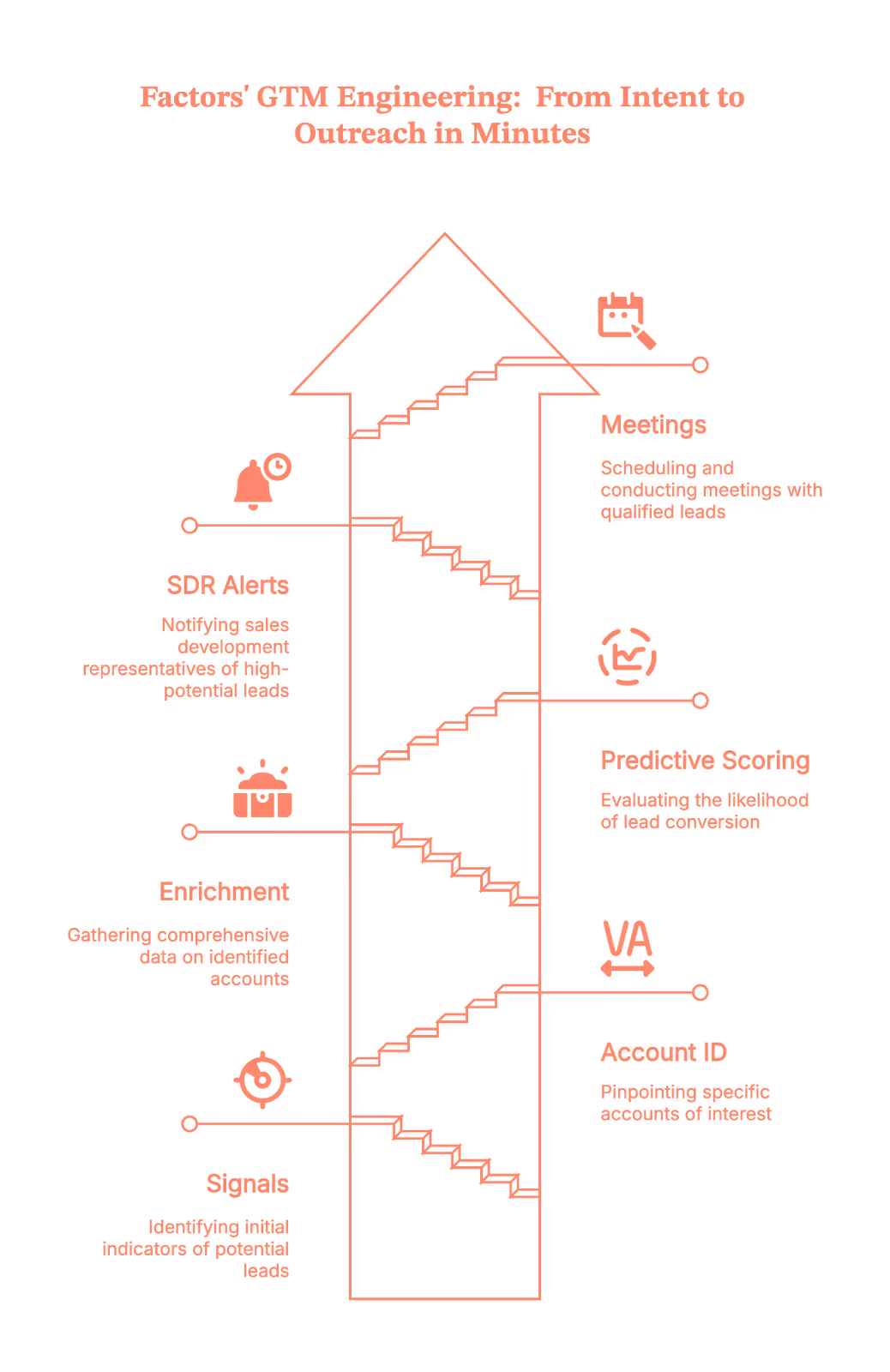
Okay, but why does this matter now? Because everyone’s doing it (Just kidding)
- Speed wins. Buyers do a lot of research before talking to sales. If you reach out first (and with context), you're more likely to make the shortlist.
- Efficiency is everything. Ad budgets are tight; headcount isn’t infinite. Intent + automation = more meetings per rep, with less chaos.
- Sales teams need clarity, not ‘heads-up’ pings. A good alert says who, why now, who to contact, and what to say. (Not ‘someone from Acme visited lol.’)
The 5-Step Playbook to Turn Visitors into Warm Outbound Play (Run this today)
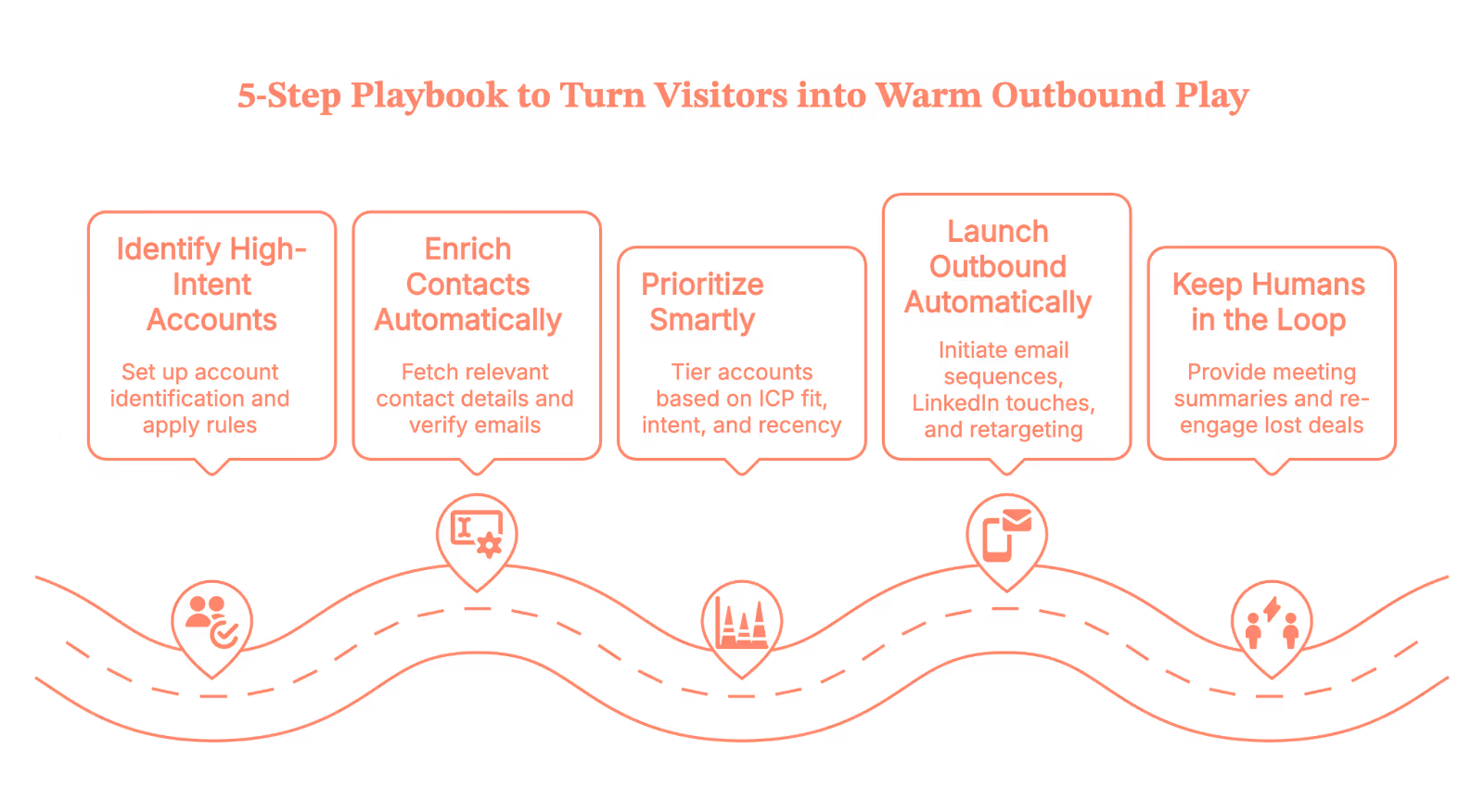
1) Identify high-intent accounts (with Factors)
Set up account identification on your site so you see company, industry, size, location, and what they did (pricing page, comparison page, sessions, etc.). Then add simple rules:
- ICP fit: e.g., Software/IT/Education, US/Canada, 50–500 employees
- Intent filters: e.g., ‘viewed pricing or product pages for ≥60 seconds,’ ‘multiple sessions in 24 hours,’ or ‘visited competitor comparison’
Pro tip: Start with two high-yield streams:
- High-intent ICP (net-new)
- Closed-lost/churned revisits (exclude super-recent losses so you don’t look clingy)
When an account matches, Factors fires real-time alerts and links directly to the account’s journey (so reps see context in one click).
(Because ‘context switching across 12 tabs’ isn’t a growth strategy.)
2) Enrich contacts automatically (this is where GTM engineering shines)
Identifying the company is half the job. The other half is finding the right people with verified emails, without sending SDRs on a copy-paste safari.
Here’s the flow your GTM engineering layer runs behind the scenes:
- Trigger: A Factors alert hits your orchestration tool (Make.com, Zapier, or Clay).
- Journey pull: Fetch last-30-day activity from Factors (pages, sessions, ad touches) into a working sheet.
- Apollo enrichment: Call Apollo to fetch relevant titles/regions/seniority; capture work emails and verification status.
- CRM hygiene: Check HubSpot/Salesforce for duplicates; tag new/existing; write updates.
- Prep the alert: Bundle the journey + top contacts so Slack shows reps who to email first (and why).
Net result: Your team gets verified contacts from the right account, in minutes, without manual chasing.
3) Prioritize smartly (so reps take the next best action)
Not every account deserves a same-day call. Use lightweight tiering so your team focuses on impact, not volume:
- ICP Fit: Expected ACV, win rate, segment (SMB/MM/ENT)
- Intent: Page depth, frequency, topics (pricing/competitor pages > ‘what is’ blogs)
- Recency: Last activity (fresh beats stale)
- Engagement: Channels and content they cared about (ad → landing page ≠ casual blog skim)
Factors’ Account Tiering and Contact Relevance agents do this automatically, grouping buying committees, ranking contacts, and even generating ‘why this person’ reasons.
Tier 1 goes to Sales now; Tier 2 gets Sales + Marketing; Tier 3 goes into the nurture phase.
(Think of it as ‘do the clever things first.’)
4) Launch outbound automatically (without being creepy)
Once you have account + contacts + context, GTM engineering fires multichannel plays:
- Email sequences (via Apollo or Smartlead), personalized to the topic/page cluster
- LinkedIn touches (connection requests and light interactions via tools like HeyReach/Trigify)
- Precision retargeting (show the right creative to live ICP visitors)
- Slack alerts so reps can jump in when Tier 1 accounts are active
Messaging rule of thumb: reference adjacent, observable signals (‘teams like yours comparing X/Y often ask about…’) instead of ‘we saw you on the pricing page at 3:17 pm.’(Because… yikes.)
5) Keep humans in the loop, then measure like a hawk
Automation should tee up great conversations, not replace them.
- Meeting Assist: AEs get pre-meeting summaries (firmographics, interest areas, pre/post-visit pages) for tailored follow-ups.
- Closed-lost re-engage: If a lost deal resurfaces, reps get the journey + refreshed contacts (and a reason to re-open the thread).
- Daily digest: Leadership sees which regions and tiers are heating up.
Track the entire intent funnel, not just opens:
- Identified → ICP → Enriched → Assigned → Contacted → Replied → SQL → Demo → Opp → Closed-Won/Lost
- Compare tiers, personas, channels, and sequences. Tweak filters (who we target) and copy (what we say) each week.
A 3-minute micro-play (to show how this feels)
Let’s say a closed-lost account, ‘Acme Corp’, revisits your pricing page (You feel that little heartbeat spike, right?)
Here’s how that moment turns into a meeting, automatically:
- Trigger (instant): Factors spots the visit and tags it as a Closed-Lost Revisit, no manual digging, no delays.
- Collect & Enrich (under the hood): Make.com flow pulls the last 30 days of journey data from Factors, then calls Apollo to fetch role-relevant, verified marketing and sales contacts. Duplicates get checked against your CRM, so records stay clean.
- AI Assist (context you can use): OpenAI summarizes the journey (top pages, themes) and prioritizes contacts by geo, title, and seniority, so reps know exactly who to hit first.
- Slack Handoff (minutes later): Your SDR receives a ready-to-act card with the next best step already included.
- Action (human, fast): The rep tweaks a line or two and hits send. Warm, informed, and perfectly timed.
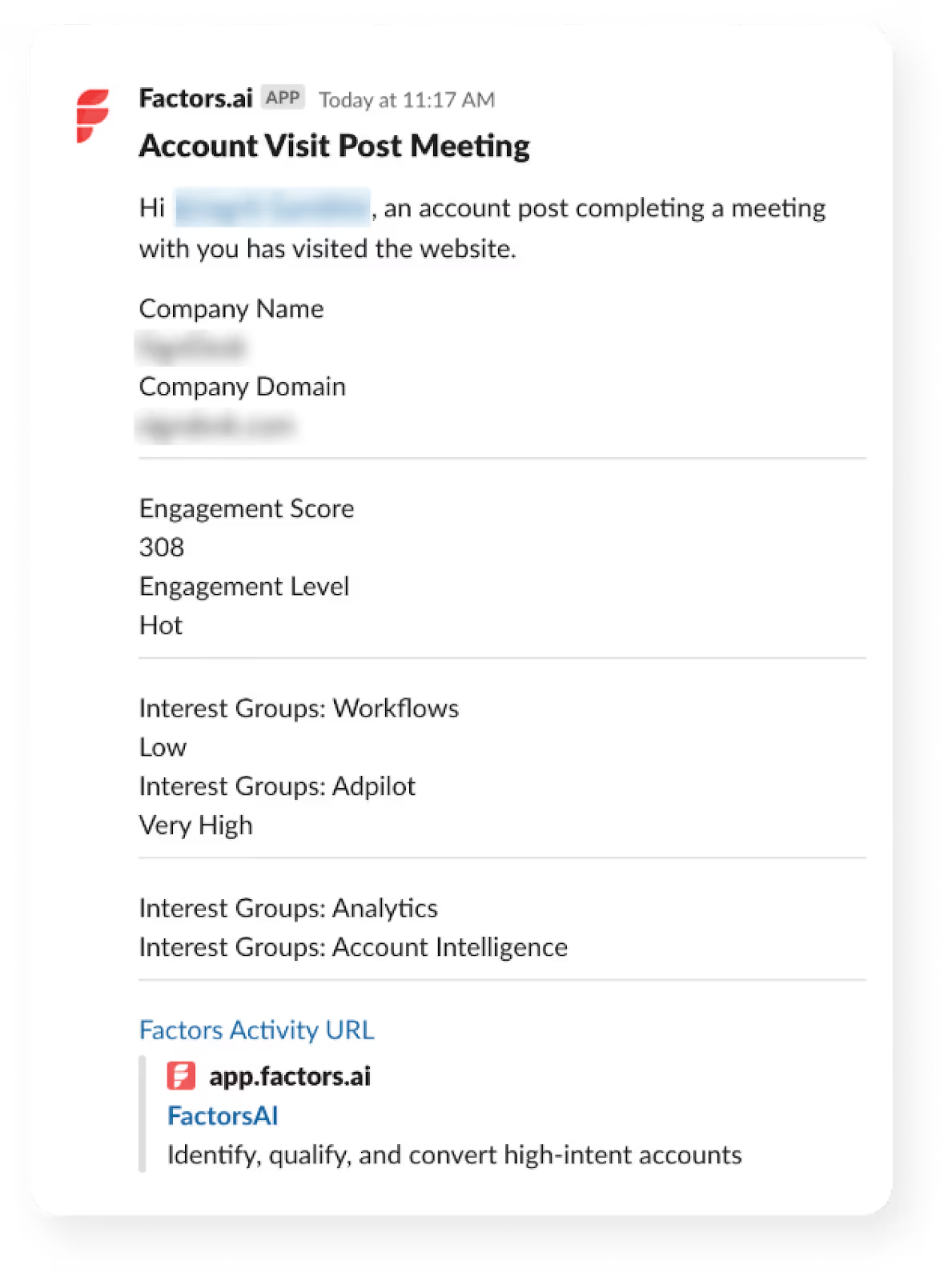
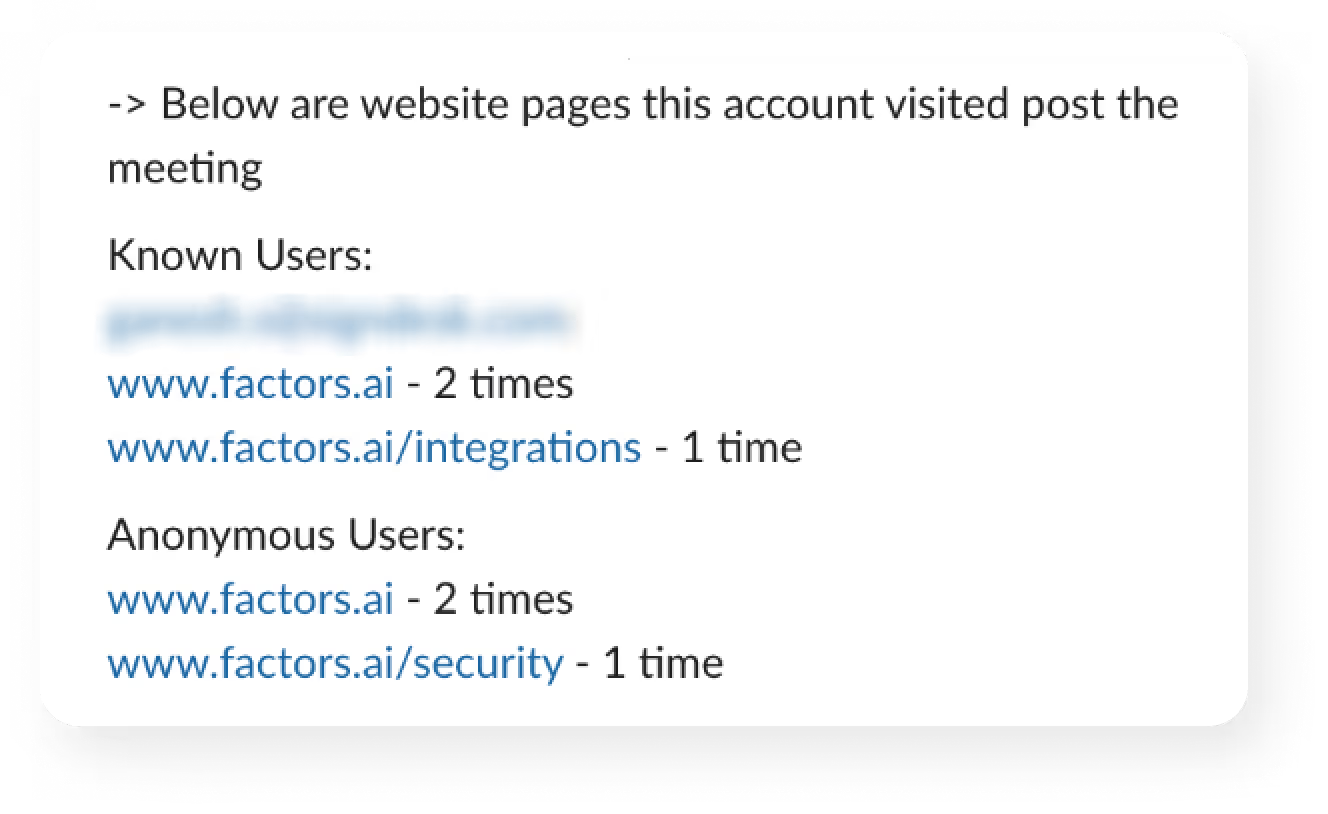
Ready to catch the next one?
Why teams pick Factors.ai for intent-driven outbound
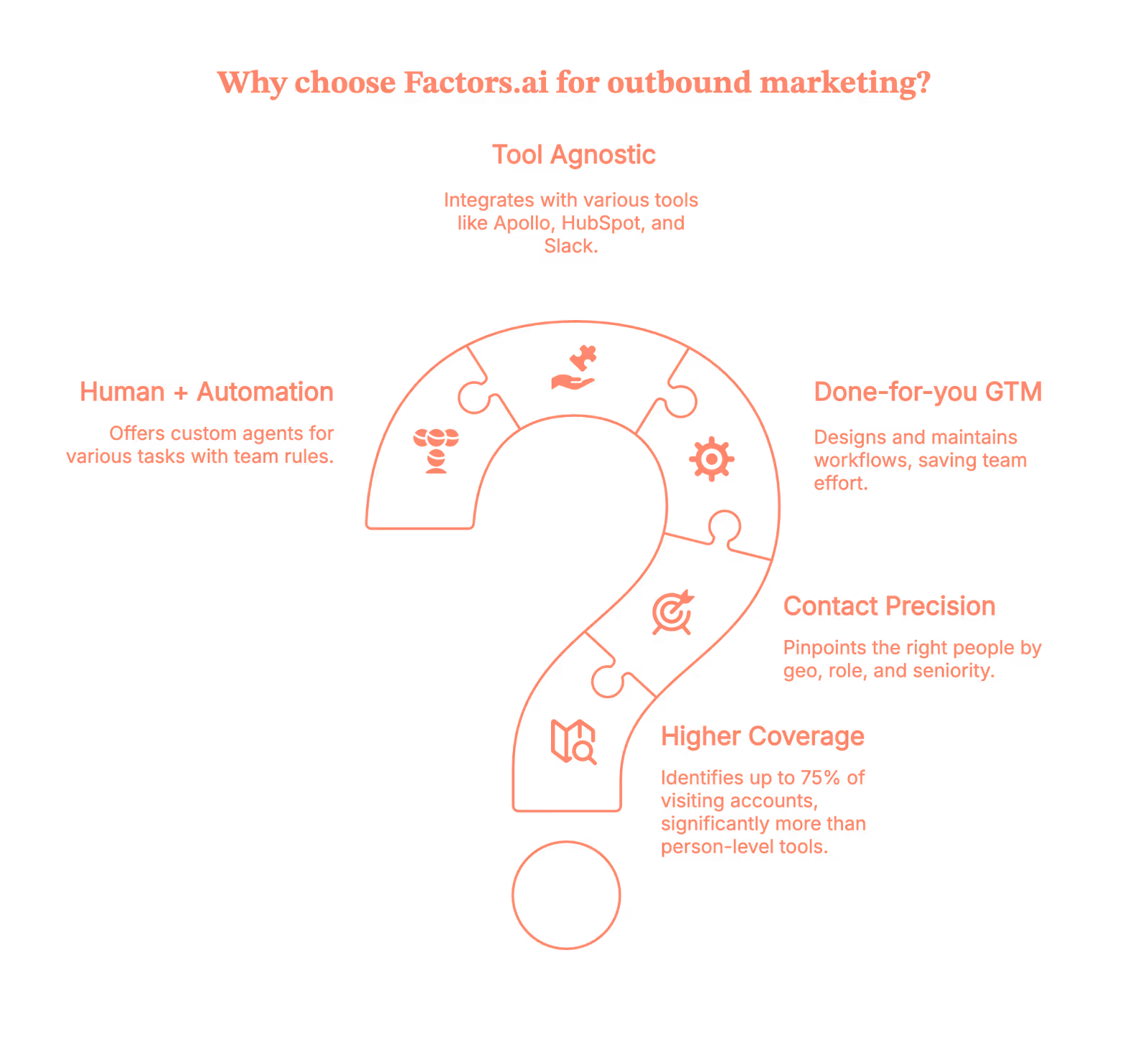
- Higher coverage: Identify up to 75% of visiting accounts (vs 8–10% person-level tools).
- Contact-level precision: Pinpoint the right people by geo, role, seniority, and buying group using user geo + job title triangulation.
- Done-for-you GTM engineering: We design, build, and maintain the workflows, so you don’t.
- Tool-agnostic, outcome-first: Use Factors with Apollo, HubSpot/Salesforce, Slack, Make/Zapier/Clay, Google Sheets, and your ad stack.
- Human + automation: Custom agents for Account Qualification, Contact Relevance, Account Tiering, Account Mapping, Meeting Assist, and Closed-Lost Alerts, with your team’s rules baked in.
(Short version: fewer ‘busywork’ pings, more booked meetings.)
Now, your move
If you’ve got traffic but not enough conversations, you don’t need ‘more leads.’ You need to activate the intent you already have, and do it automatically.
Factors identifies who’s on your site, uses GTM engineering to enrich and prioritize accounts, and delivers ready-to-send outreach to your reps in minutes.
Book a demo, and we’ll show you your high-intent accounts, the exact contacts to reach, and the workflows that make outbound feel (almost) effortless.
You’re closer to your next best deal than you think. Let’s go get it.
Quick FAQ on GTM engineering services from Factors.ai (because your team will ask)
Q. Will this spam Slack?
A. No, alerts are filtered by ICP + intent + tier. Everything else goes to a digest.
Q. Are the emails any good?
A. We use context from buyer journeys and your rules to generate short, human drafts. Reps keep the voice; automation kills the busywork.
Q. What if our ops team is small?
A. That’s why GTM engineering services exist. We build and maintain the flows; you enjoy the pipeline.

GTM Engineering vs. RevOps: Why They’re Not the Same Job (Even If LinkedIn Really Wants Them to Be)
Picture this.
You’re in a meeting, someone brings up hiring a “GTM Engineer,” and suddenly half the room nods like they understand… while the other half quietly panics and starts questioning all their life choices.
Did we miss something?
Is this a real role?
Is everyone hiring them except us?
Yeah. That’s the vibe around GTM Engineering right now.
The truth?
RevOps and GTM Engineering are connected, but they’re not interchangeable.
And if you treat them like the same job, you’ll end up hiring someone amazing… for the wrong thing.
So let’s break this down in a way that actually makes sense.
Related read: Top GTM engineering tools for marketing and sales teams.
TL;DR
- RevOps = alignment and execution; GTM Engineering = automation and scale, confusing the two causes costly hiring mistakes.
- GTM Engineers need firsthand sales experience and build systems from scratch; RevOps optimizes what already exists.
- Roles differ in compensation, tooling, and team alignment. RevOps works across functions, and GTM Engineering sits closer to Product and Data.
- Your growth stage determines who to hire: RevOps for order, GTM Engineering for leverage, never the other way around.
First, let’s get our definitions straight
Before we stir the pot, here's the quick, no-nonsense version:
RevOps = alignment + process + predictability.
They make sure Sales, Marketing, and CS are speaking the same language, running the same playbook, and not tripping over one another.
GTM Engineering = automation + architecture + technical GTM execution.
They build AI-powered workflows, scripts, agents, and automations that create revenue leverage at scale.
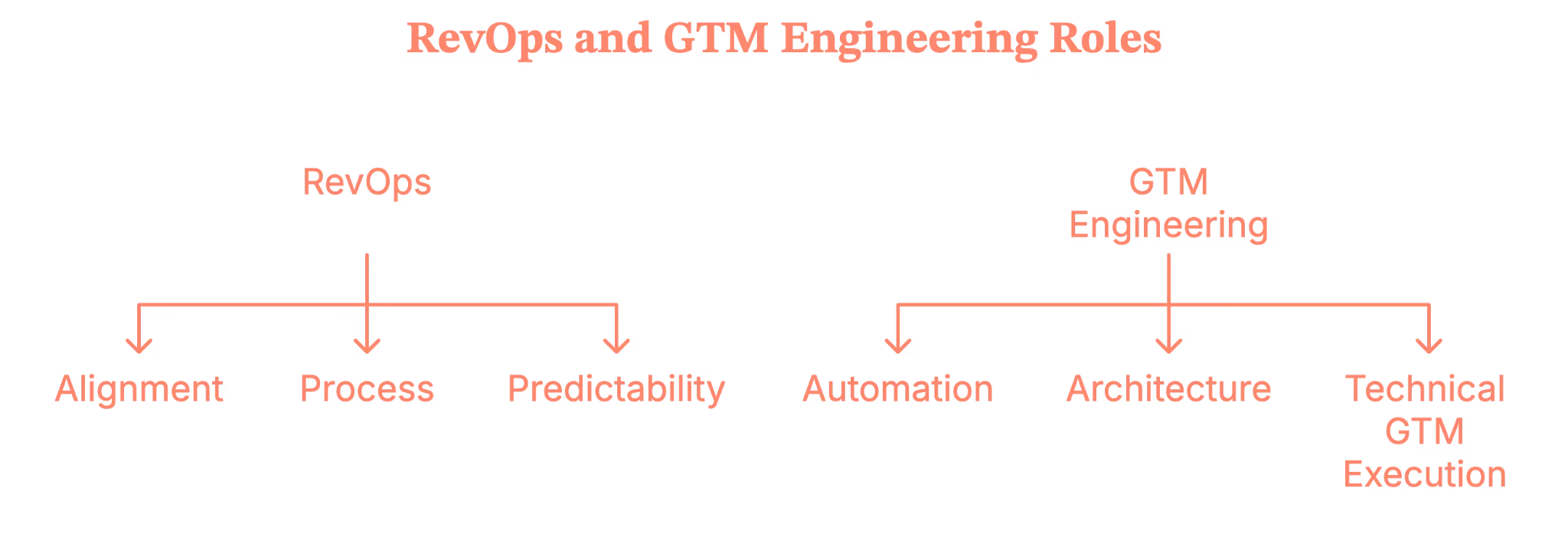
Both roles touch tools.
Both touch data.
Both help you grow.
But they’re not interchangeable, and treating them like they are is how you end up hiring a Zapier power-user when you needed someone who understands pipeline governance (or vice versa).
Related read: Website visitor to warm outbound play using GTM engineering
What RevOps actually does (No, it’s not just dashboards)
Now imagine this, you’ve hit that awkward growth stage where:
- Data stops making sense,
- Your CRM becomes a black hole,
- Teams debate whose pipeline number is “right.”
- Someone sincerely suggests, “Maybe we need another field.”
This is the moment RevOps becomes real.
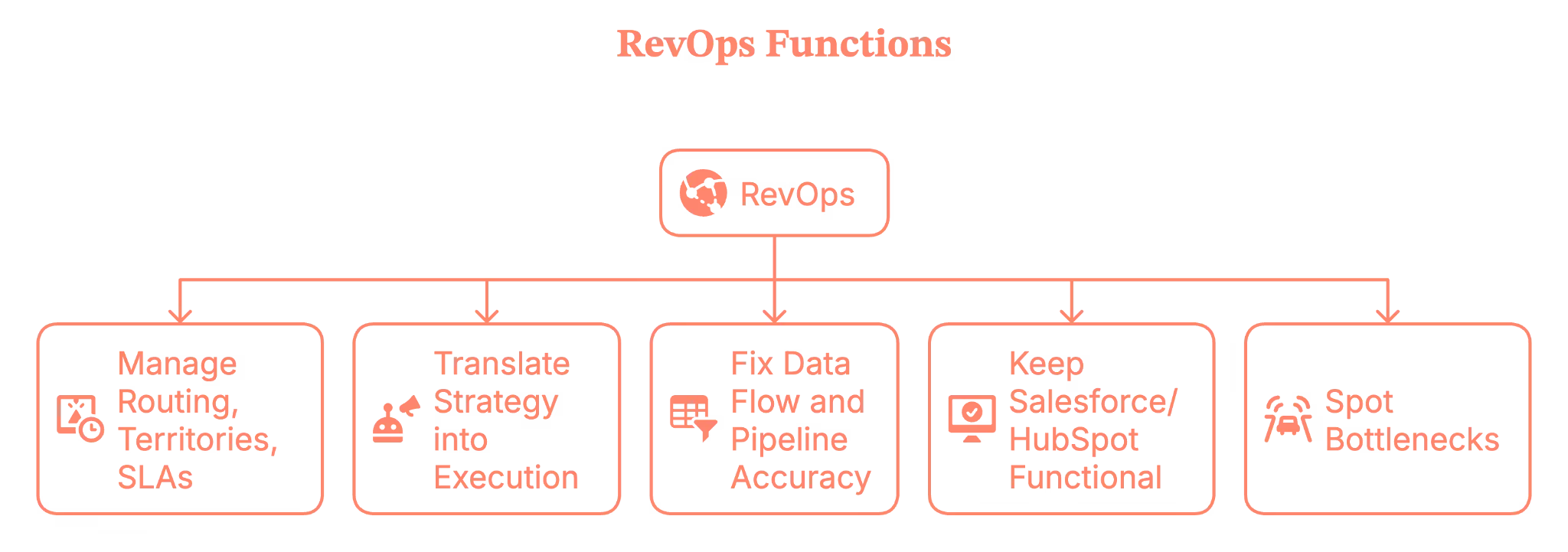
RevOps is the function that:
- Manage routing, territories, SLAs, and your GTM governance
- Translate strategy (CEO/CRO/CMO) into execution
- Fix data flow and pipeline accuracy
- Keep Salesforce/HubSpot and the entire stack functional
- Spot bottlenecks before they sabotage your quarter
If GTM is the engine, RevOps is the person making sure the wheels don’t fall off while everyone else is yelling “faster!”
Okay… So what’s a GTM engineer then?
Here’s where the waters get muddy.
Some people say “GTM Engineer” and mean:
- Building prospect lists
- Scraping contacts
- Automating outbound with Clay, n8n, Make, or Zapier
- Wiring together tools for faster outreach
Is it useful work? Absolutely.
But is it a new role? Not really. That’s classic Sales Ops with modern toys.
But true GTM Engineering is something else entirely.
A real GTM Engineer:
- Builds net-new automation using AI, APIs, and scripts
- Creates automated workflows that actually touch prospects
- Works closely with Product, Data, and Platform teams
- Turns GTM ideas into executable systems
- Helps scale motions that humans can’t keep up with manually
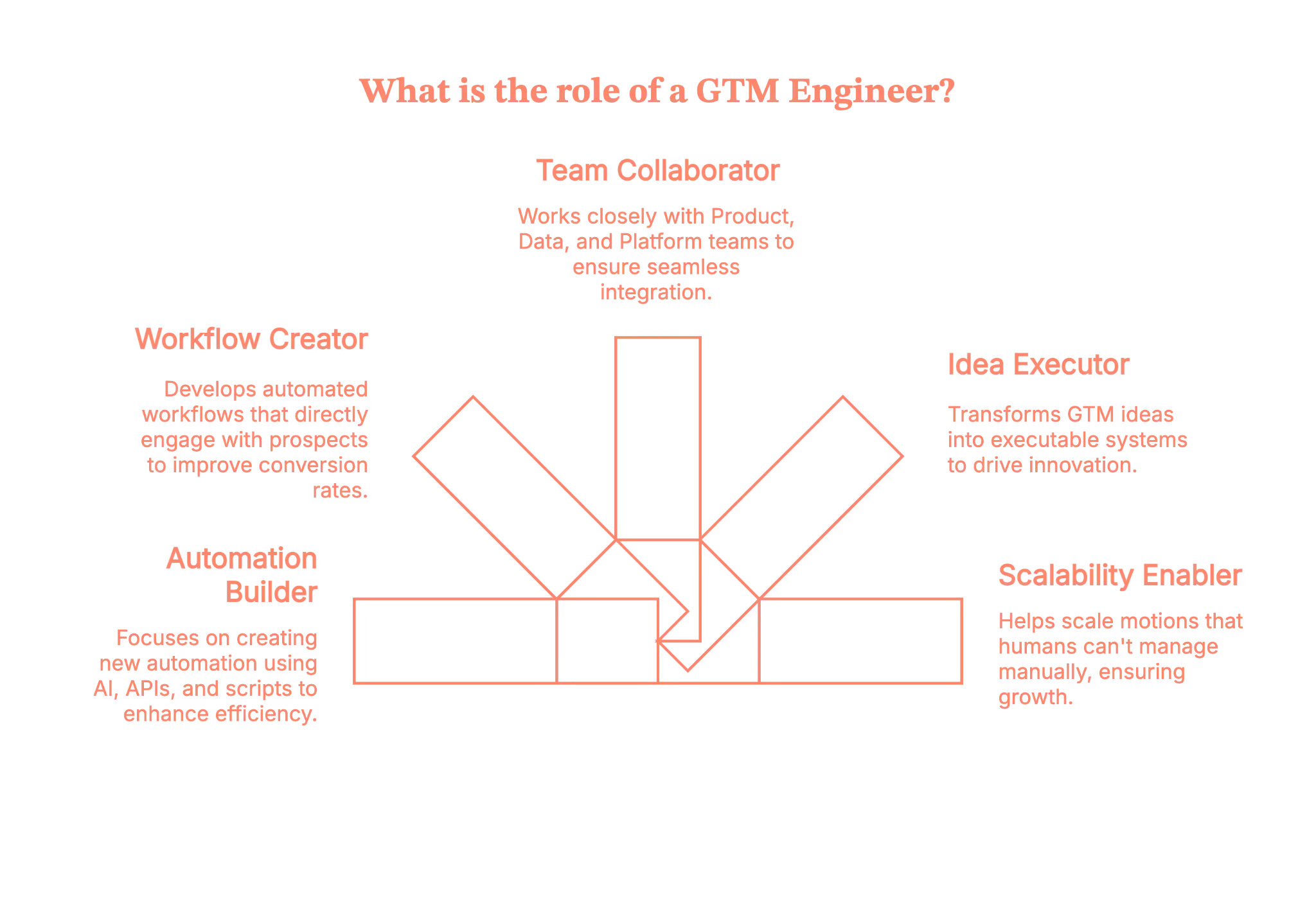
Where RevOps operates inside the existing system, GTM Engineering builds the systems that don’t exist yet.
This is not “run Clay better.” This is “architect GTM like an engineer.”
And it belongs in the category of “new job family created by the AI-native GTM era.”
Why GTM Engineering isn’t just revOps with a trendy title
According to Brendan Short, the founder of The Signal (.club), there are eight reasons why GTM Engineer is not just RevOps rebranded.
Let’s lay this out clearly, because this is where companies make expensive hiring mistakes.
1. The experience factor
A strong RevOps leader doesn’t need SDR or AE experience.
A strong GTM Engineer almost always does, because they automate messaging, outreach, enrichment, tiering, and buyer interactions.
You simply cannot automate what you don’t understand firsthand.
2. The incentives are different
RevOps is compensated like an operations role.
GTM Engineering should be compensated like a revenue role, with pay tied to outcomes rather than task completion.
Different incentives create different behaviors, which ultimately create different results.
3) They build new infrastructure; they don’t patch old workflows
RevOps focuses on optimizing existing systems such as Salesforce and HubSpot.
GTM Engineers build entirely new systems using LLMs, APIs, microservices, agents, and data pipelines.
These require completely different technical skills.
4) They are not responsible for classic RevOps work
GTM engineers do not manage comp plans, forecast models, territory logic, or admin-heavy tasks. Those responsibilities belong to RevOps.
5) Their work touches customers, even if indirectly
GTM Engineers automate actions that reach real buyers, not just internal reports. This raises the stakes and lowers the margin for error.
6) They sit closer to Product and Data than to Sales or CS
GTM engineers need access to internal APIs, event systems, and warehouse infrastructure — areas RevOps rarely works in.
7) They are built for a post-SaaS, AI-native GTM world
Buyer behavior changes quickly, volume is high, and speed matters. GTM Engineers help teams operate at a pace humans alone can’t maintain.
8) Their output is leverage, not insights
RevOps provides clarity through reporting and structured processes. Whereas GTM Engineering provides scalable automation that compounds over time.

Together, they’re powerful, but confusing them makes hiring far more difficult.
So, why is everyone confused right now?
Well, the short answer is LinkedIn hype cycles.
The long answer is,
- Tools like Clay and n8n make GTM feel more “technical.”
- Influencers start rebranding their workflows as “GTM Engineering.”
- Founders worry they’re behind.
- Operators assume they need a deeply technical hire instead of a strategic one.
- Titles start driving decisions instead of needs
It’s like when Excel wizards started calling themselves “financial engineers.”
Yes... same energy, but a different decade.
Where teams get this wrong (and create their own chaos)
A little tough love:
Using Clay doesn’t make you a GTM strategist. And knowing n8n doesn’t make you a GTM leader.
Tools are not a strategy.
If you let “GTM Engineers” define your GTM… you end up with a tool-driven motion instead of a customer-driven one.
And that’s how companies burn cycles chasing clever automations while ignoring why customers buy them in the first place.
What you actually need, based on your growth stage
Let’s make this simple enough to tape to your founder’s desk.
Pre-$1M ARR
You need:
- Clear ICP
- Simple repeatable processes
- Low-maintenance tools you can manage (Notion, Clay, ChatGPT)
No RevOps yet and definitely no GTM Engineering. You need clarity, discipline, and direct customer learning.
$1M – $5M ARR
This is where a Sales Ops or RevOps generalist becomes essential. You need someone to
- Build dashboards
- Build your CRM
- Clean your data
- Build early GTM processes
- Prevent operational chaos
Their value comes from judgment and prioritization, not advanced tooling.
$5M+ ARR
Now things get fun.
Once you reach this stage, complexity increases. You have:
- Multiple motions
- More channels
- Large teams
- More data
- Rising automation needs
This is when RevOps evolves into a strategic function and when GTM Engineering finally becomes relevant.
You bring these roles in not because LinkedIn says so, but because your business genuinely requires them.
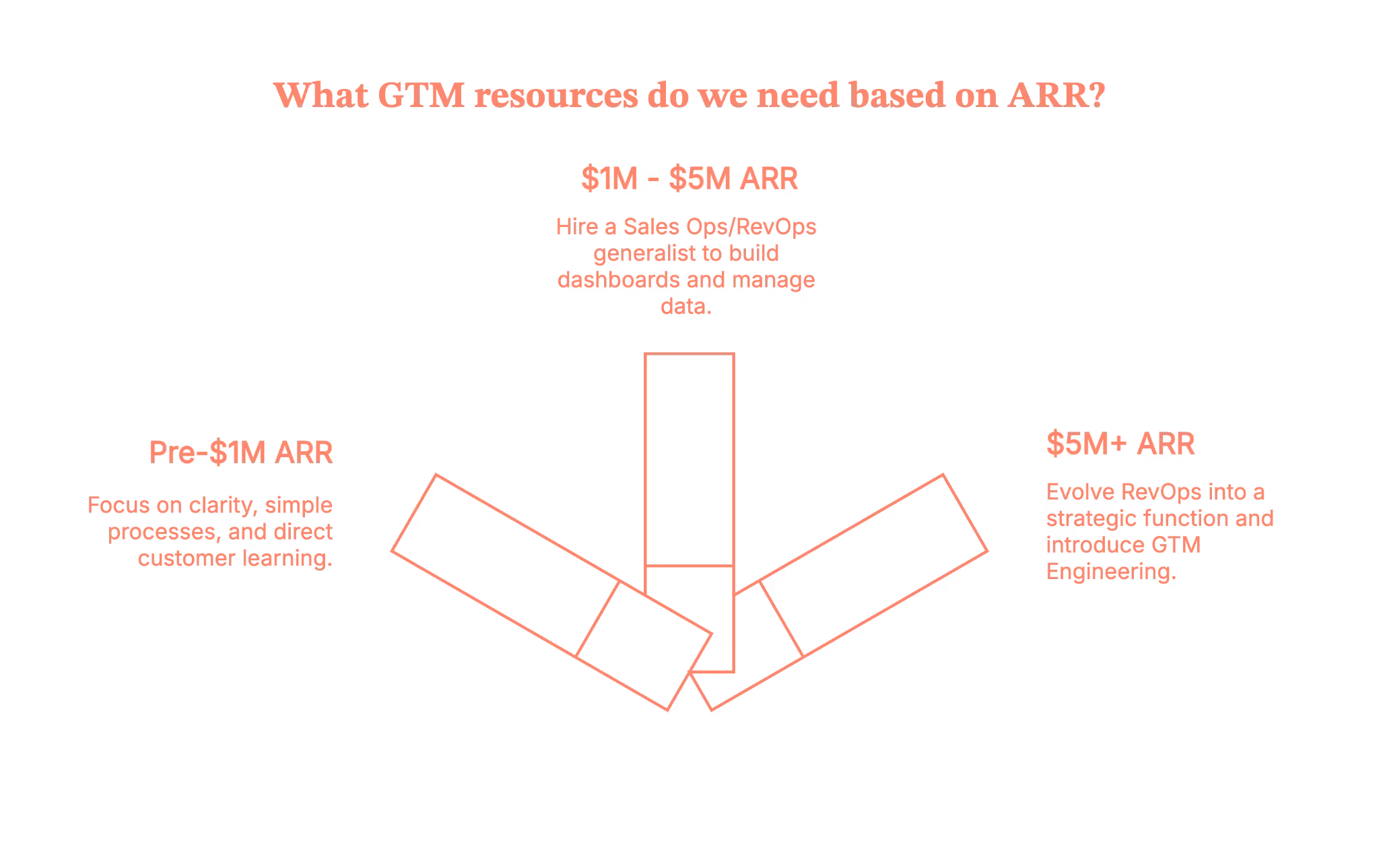
So… which one should you hire first?
The rule is simple, and it rarely fails.
If your business needs alignment, you should hire RevOps first. On the other hand, if your business needs scale, you should hire GTM Engineering first.
When companies confuse the two, they hire the wrong person and unintentionally build the wrong GTM motion.
Unfortunately, this mistake shows up on LinkedIn every single week.
Wrapping this up (Before another new job title drops)
Let’s call things what they are.
- Founders are responsible for setting the strategy.
- RevOps is responsible for turning that strategy into predictable and aligned systems.
- GTM Engineering is responsible for building the technical automation that scales those systems.
Buzzwords will change, titles will trend, and tools like Clay will continue to inspire new job names, but the fundamentals remain the same.
Revenue still needs to be operated. Buyers still need to be understood. And GTM still needs real people who know how to make the motion work.
So do not hire based on hype; hire based on what your business genuinely needs right now.
When you get the roles right, the entire GTM engine runs smoother and grows faster.
Flip your GTM from “nice reports” to “net new revenue” with Factors.ai GTM engineering
With Factors’ GTM engineering services, your tools finally start acting like one smart revenue system instead of a messy pile of apps. You’ll identify up to 75% of accounts visiting your website, enrich the right buyers with verified emails, and hand reps ready-to-send outreach in minutes.
Instead of copy-pasting across tabs, your team runs in a tight loop: detect → enrich → prioritize → alert → execute → write-back. Everyone’s working from the same context, nobody’s asking “Who owns this?”, and intent isn’t cooling off while ops cleans up spreadsheets.
Want to see it on your data? Book a demo and watch the full flow in action. It is configured around how your outbound team actually works (we’ll even bring sample plays you can steal and ship).
How we work
- Done-with-you: we co-build flows with your RevOps team (hands on the keyboard, full enablement).
- Done-for-you: we design, implement, and document; your team just runs the machine day-to-day.
Ready to tighten your loop and let the system do the busywork?
FAQs on GTM Engineering vs. RevOps
Q. What does a GTM Engineer actually do, and how is that different from RevOps?
A GTM Engineer designs and builds revenue systems: AI-powered workflows, data pipelines, automations, enrichment flows, and outbound engines that touch real prospects and customers. Their work lives in tools like Clay, CRMs, APIs, event streams, and data warehouses, turning go-to-market ideas into working automation.
RevOps, by contrast, owns process, governance, and cross-functional alignment: routing, territories, SLAs, forecasting structure, CRM architecture, and reporting. RevOps keeps the machine reliable and consistent; GTM Engineering builds new “engines” that extend what that machine can do.
Q. Is “GTM Engineer” a real job or just a hyped-up title?
Some Redditors argue that “GTM Engineer” is mostly branding on top of Growth/RevOps work, especially when the role is just Clay/Zapier automation with light strategy. Others see it as an emerging specialty: a hybrid of sales, marketing, ops, and technical automation that deserves its own label, especially as AI tooling becomes more central.
Q. When should a company hire RevOps vs. a GTM Engineer?
If you’re fighting messy data, misaligned teams, unclear ownership, or broken handoffs, you’re in RevOps territory. You need someone to define the process, own the CRM, standardize reporting, and keep Sales, Marketing, and CS marching together.
A GTM Engineer makes more sense once you already have basic revenue operations in place and now need scale: higher outbound volume, complex routing/enrichment, AI-driven workflows, or sophisticated multi-tool automations that your existing team can’t maintain.
Early-stage companies usually start with RevOps (or RevOps-ish generalists) and add GTM Engineering as motion complexity and automation demand increase.
Q. Does a GTM Engineer need to know how to code or come from sales?
Here are the two patterns we observed:
- Many GTM Engineers come from sales, SDR, or RevOps and later pick up technical skills. That background helps them automate outreach, qualification, and follow-up in a way that actually matches how reps work.
- Technical depth varies: some roles lean heavily on low-code tools; others expect scripting, API work, and basic data engineering.
Pure software-engineering ability without go-to-market experience often underperforms. You can’t automate a motion you don’t really understand from the front lines.

What Is GTM Engineering Integration? (And Why Your Stack Will Breathe a Sigh of Relief)
Ever feel like your GTM tools are in five different group chats, all ignoring each other? Marketing sees intent. Sales wants contacts. Ops wants a clean CRM. Meanwhile, your buyer is doing 80% of their research before they ever talk to you (and clicking away while you copy and paste between tabs). Sound familiar?
If only there were a way to make your apps talk, move, and act like one team… Good news, there is.
GTM engineering integration connects your external apps, including Factors.ai (account ID and journeys), Apollo (contacts), HubSpot/Salesforce (CRM), Slack/Teams (alerts), and orchestration layers like Make.com, Zapier, and Clay, so data flows automatically and outbound triggers fire at the right moment.
Yes, even when you’re not staring at the dashboard.
TL;DR
- GTM integrations connect siloed tools, allowing data to flow automatically from web visits to outbound sequences.
- It delivers real-time alerts with enriched contacts and tailored context, right where reps work.
- This also reduces manual work by syncing enrichment, CRM updates, and outreach steps.
- Prioritize the right accounts using AI-enabled predictive account scoring, rule-based filters, and territory routing to optimize your sales strategy.
The 30-second version: from signal to conversation
A high-intent account hits your pricing page:
- Detects the visit (Factors)
- Enriches likely buyers (Apollo)
- Prioritizes with rules/AI (OpenAI)
- Alerts the right rep (Slack/Teams)
- Writes cleanly to CRM (HubSpot/Salesforce)
- Launches email/LinkedIn plays (Apollo/Smartlead, HeyReach/Trigify)
Result: Reps receive context, contacts, and copy while the intent is still warm (ideally piping hot).
To read more about the process, check our Website visitor to warm outbound play using GTM engineering services page.
Why GTM engineering integration matters
Every modern GTM team runs multiple point tools (identification, enrichment, sequencing, chat, ads, analytics). Left unintegrated, they create data silos and slow handoffs. Meanwhile, buyers conduct most of their research before speaking with sales teams.
Translation: speed + context is everything.
- Break silos so everyone works from the same, current account intel
- Automate handoffs end-to-end (detect → enrich → outreach)
- Ground outreach in context, not guesswork
- Use AI for summaries, prioritization, and drafting—based on trusted data
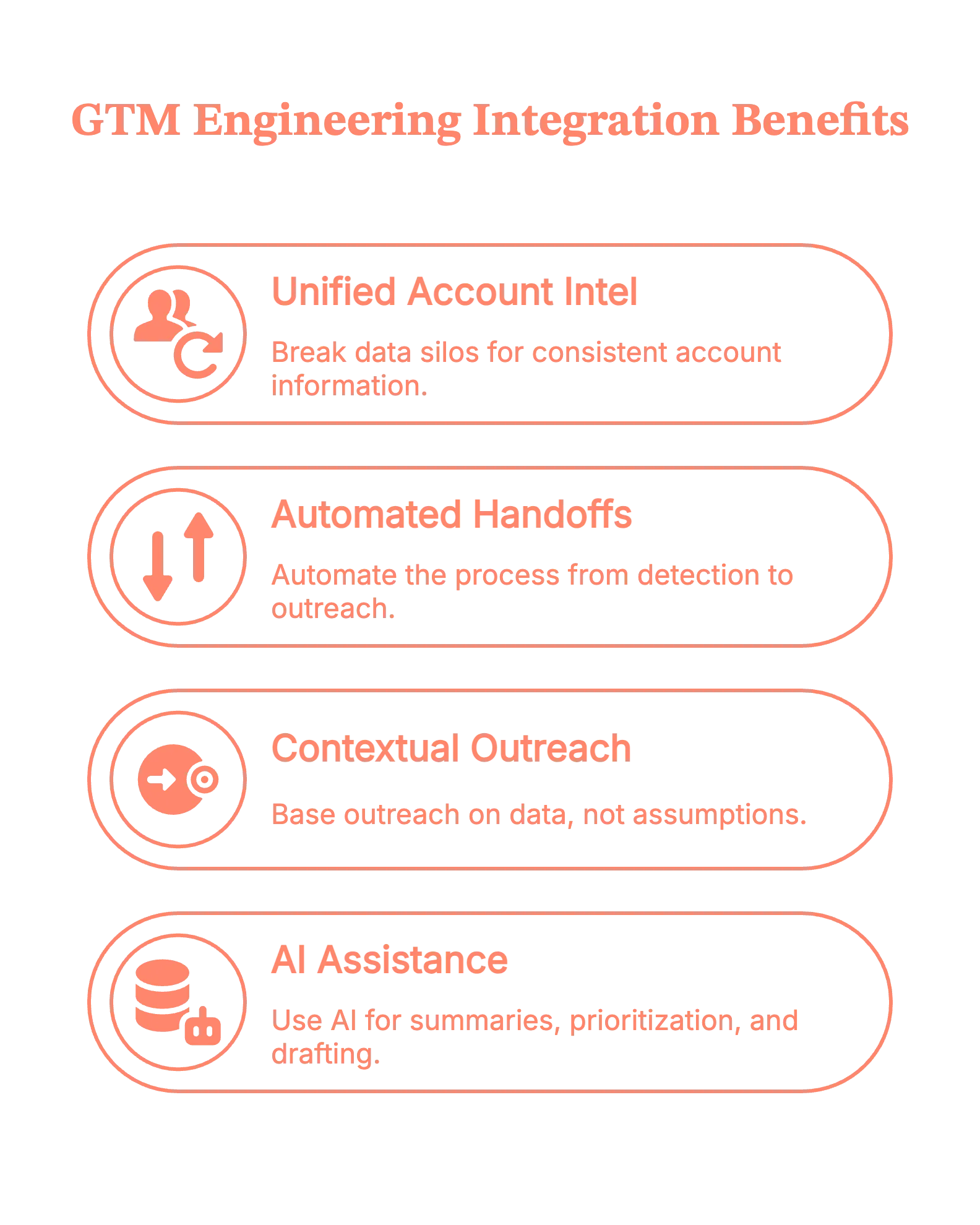
Psst! Teams identify up to ~75% of visiting accounts with Factors.ai and reach verified decision-makers faster via Apollo.
5 types of GTM engineering integrations
- Data & detection: Factors.ai for website visitor identification, customer journeys (last 30 days), and signals from LinkedIn/Google Ads, G2, and product activity.
- Orchestration: Make.com (primary)/N8N, plus Zapier/Clay.
- Enrichment & research: Apollo API (contacts vs. people, verified work emails, employment history).
- CRM, storage & collaboration: HubSpot/Salesforce (de‑dupe, create/update, tasks/ownership). Google Sheets/Docs (working tables; research + outreach drafts).
- Activation & comms: Slack/Teams (territory‑aware alerts with deep links to Factors journeys). Apollo/Smartlead (email sequences), HeyReach/Trigify (LinkedIn), ad platforms (retargeting).
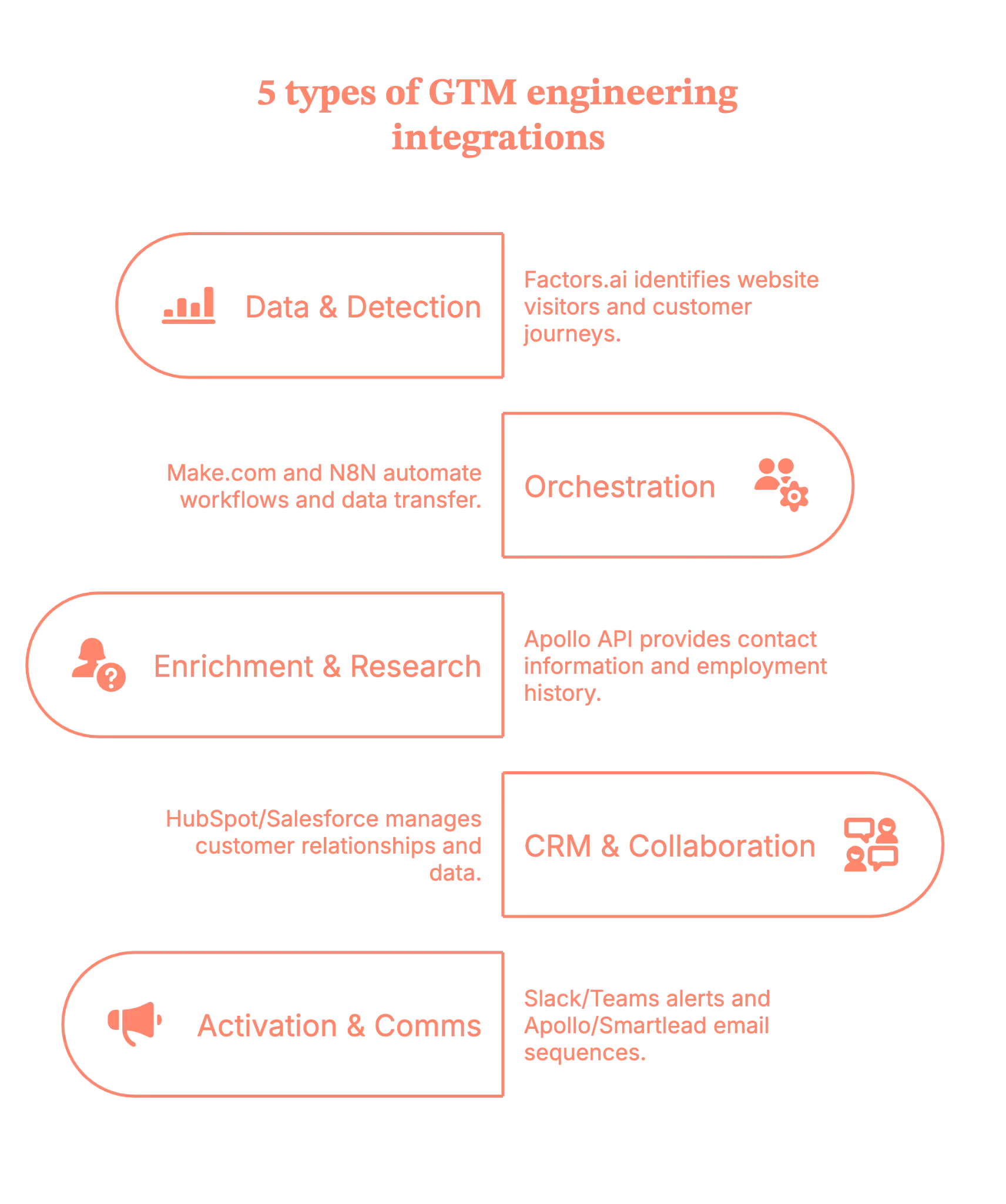
7 practical steps to make the GTM engineering integration live in your stack
Step 1: Map your signals in Factors (what happened, and when)
Define your ICP and intent rules inside Factors.ai. Pull in journeys for the last 30 days and connect signals from LinkedIn/Google Ads, G2, and product activity.
Tip: Start with pricing pages, docs, and comparison pages. That’s where intent gets loud.
Step 2: Orchestrate the flow with Make.com/N8N (your switchboard)
Use Make.com/N8N as the primary runner (Zapier/Clay as needed). Trigger on the Factors.ai event (the customer journey).
Guardrail: Keep a ‘companies processed’ list separately so you don’t re-enrich the same account every hour (your API credits will thank you).
Step 3: Enrich the right people via Apollo (contacts, not just ‘people’)
Call the Apollo API to retrieve details based on titles/regions/seniority, and capture verified work emails, as well as employment history.
Pro move: Filter for role relevance (e.g., ‘Director+ in RevOps/Marketing/Sales in-region') so reps don’t wade through noise.
Step 4: Keep the record of truth clean (CRM hygiene)
Upsert into HubSpot/Salesforce with de-dupe logic, set ownership, and create tasks only when the signal meets your threshold.
Little thing, big win: Tag contacts as new vs. existing so reps instantly see context (and don’t have to introduce themselves again, awkwardly).
Step 5: Prioritize with AI (what’s hot vs. merely warm)
Utilize AI to deduplicate URLs, count occurrences, segment users, and score contacts according to your rules. For example:
- Known user in the product? ★★★★★
- Same city/region as the assigned rep? ★★★★☆
- One random homepage visit? ★☆☆☆☆
Outcome: Reps start at the top of the list, and it’s the right list.
Step 6: Alert where reps live (Slack/Teams)
Send an alert to Slack/Teams with the following details:
- Account + segment
- Journey highlights (pages, recency)
- Top contacts (emails + LinkedIn)
- A draft opener
Deep link to the Factors.ai journey
(Because nobody wants to hunt for links in a maze of folders.)
With Factors.ai, your alert will look something like this.
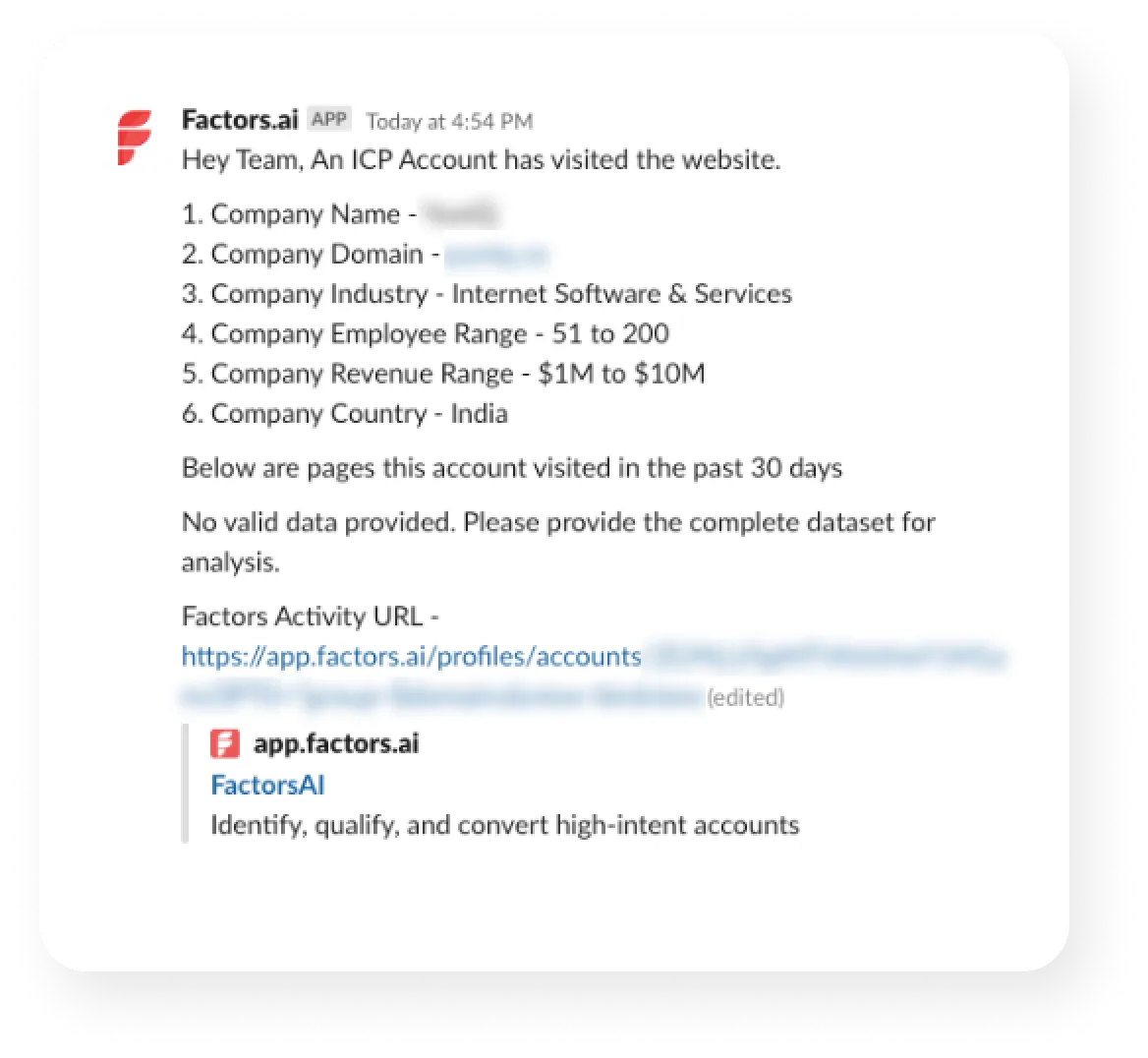

Step 7: Execute and write back (so your loop stays tight)
SDR tweaks the copy and sends via Apollo/Smartlead, adds a LinkedIn touch (HeyReach/Trigify), and the system writes back to CRM.
Why it matters: Outreach, CRM, and analytics now agree on what happened and what’s next.
No he-said-she-said across tools.
5 benefits you’ll get from GTM Engineering integrations
1) Faster time‑to‑touch
Real-time alerts and pre-enriched contacts enable reps to respond in minutes when intent is at its highest.
2) Cleaner data, fewer manual tasks
Automated enrichment (Apollo), deduplication, and CRM updates keep data accurate and eliminate ‘copy-paste operations.’
3) Higher coverage & precision
With Factors identifying up to 75% of visiting accounts and Apollo returning verified work emails, reps reach the right people sooner.
4) Smarter prioritization
Account & contact tiering (rules + AI) focuses reps on Tier‑1 opportunities.
5) Coordinated multichannel
Email (Apollo/Smartlead), LinkedIn (HeyReach/Trigify), and precision retargeting line up behind the same signal, so every touch feels timely and relevant.
Guardrails that keep your GTM engineering integrations smooth
- Add a 4-5 min sleep so alerts land after enrichment finishes
- Route by territory/geo in Slack
- Maintain exclusions (e.g., ignore losses in the last 60 days)
- Standardize card + doc templates for speed and consistency
- Log steps to a Sheet for easy QA (spreadsheets are the unsung heroes)
GTM engineering integration: The master checklist
Here is a getting-started checklist for your GTM plays.
- ICP + signals: define ICP; watch pricing/docs/comparison, G2, product usage
- First GTM plays: High-Intent ICP; Closed-Lost Revisit
- Connect apps: Factors → Make.com → Apollo → HubSpot/Salesforce → Slack/Teams → Sheets/Docs
- CRM rules: upsert by email + domain; fields: Intent_Score, Last_Intent_Source, Journey_URL; default owner
- Flow (Make.com): Trigger (Factors) → Journey API → Sheets → Enrich (Apollo) → Upsert CRM → Score (AI) → Alert (Slack/Teams) → Write-back → Sleep 4–5m
- Alert card must include: account/segment, last pages, top 2–3 contacts (email + LinkedIn), draft opener, links (Journey / Doc / CRM)
- Safeguards: exclude recent losses (60d), competitors, personal domains; ≤1 alert/account/24h; ≤3 contacts/alert; quiet hours
- QA: 5–10 test events; verify routing, links, dedupe; run a negative test (homepage-only = no alert)
- Go-live: ship copy packs; 15-min enablement; monitor first 48h; set escalation path
- Weekly metrics: Signals→Alerts→Replies→Meetings→SQLs→Pipeline; time-to-first-touch; contactability; coverage
- Iterate (weeks 2–4): tighten filters/scoring; add Form-Fill Drop-Offs + Research Pack; expand routing; add retargeting
- Definition of done: live alert with ≥2 verified contacts; outreach sent; auto CRM write-back; median TTF touch ≤30 min; meeting booked or learnings applied
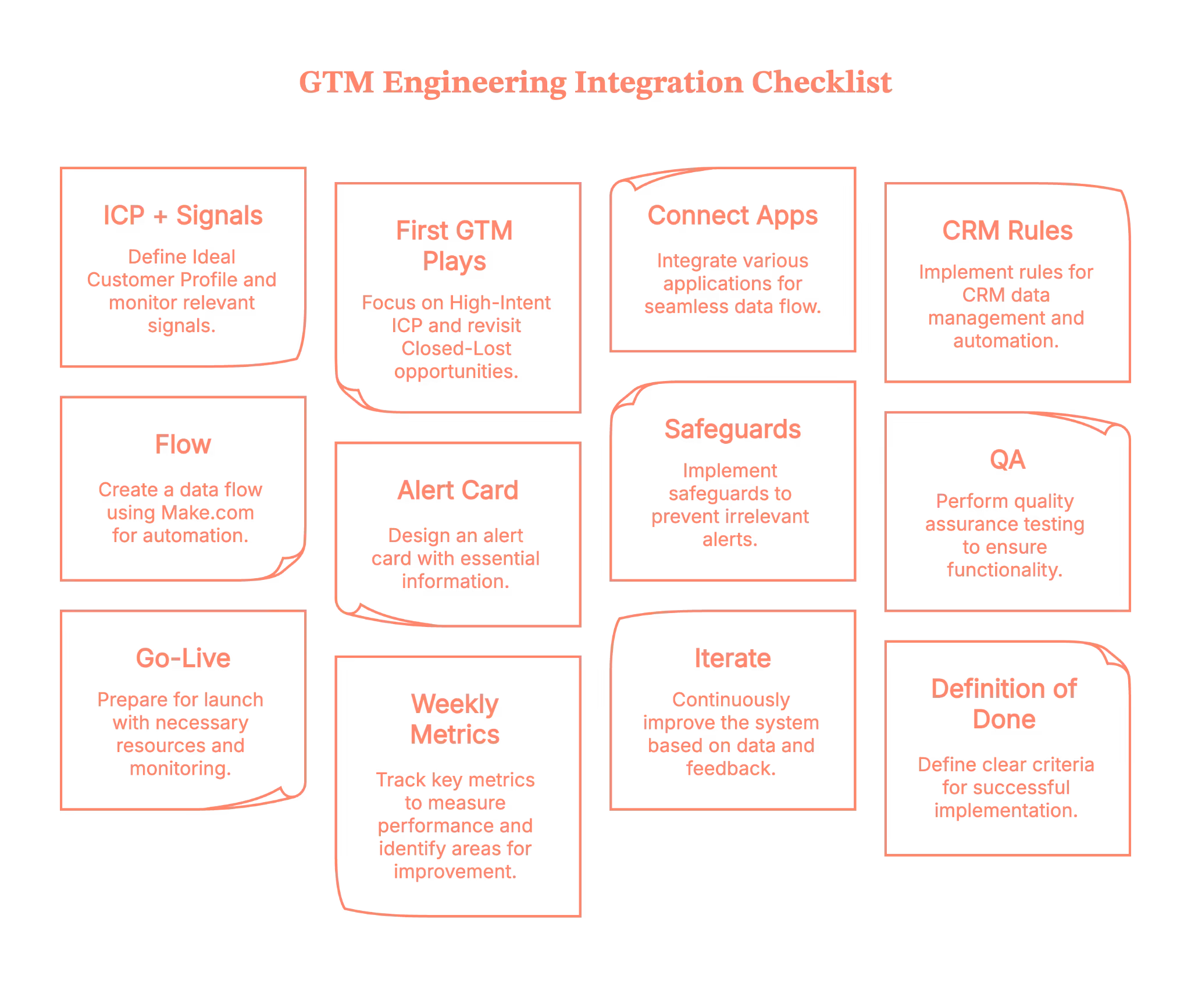
Plug in, switch on, and multiply your pipeline with Factors.ai GTM engineering services
With Factors' GTM engineering services, your stack stops acting like separate apps and starts operating like a coordinated revenue system. You’ll identify up to 75% of visiting accounts, enrich the right buyers with verified emails, and deliver ready-to-send outreach to the right rep in minutes.
Instead of copy-pasting between tabs, your team moves in a tight loop: detect → enrich → prioritize → alert → execute → write-back. Everyone sees the same context; nobody asks, ‘Who owns this?’; and intent doesn’t go cold while ops wrangles spreadsheets.
Want to see it on your data? Book a demo with us and watch the end-to-end flow—detection to Slack to CRM to outreach, run exactly the way your outbound team needs (and yes, we’ll bring sample plays you can keep).
How we work:
- Done-with-you: we co-build flows with your RevOps team (hands-on keys, full enablement).
- Done-for-you: we design, implement, and document; your team runs it day-to-day.
Ready to tighten your loop?
GTM Engineering Integration: Turning Signal into Revenue Without the Copy-Paste
GTM engineering integration is the connective tissue that transforms scattered go-to-market tooling into a synchronized, responsive revenue engine. By linking platforms like Factors.ai, Apollo, HubSpot, Salesforce, Slack, and orchestration tools such as Make.com or Zapier, teams gain the ability to act in real-time, with no swivel-chair operations or delays.
This approach captures high-intent signals, enriches accounts and contacts with verified data, writes contextually clean entries into the CRM, and triggers personalized outreach while buyer interest is still at its peak. Whether identifying buyers on a pricing page or alerting reps in Slack with enriched leads and ready-to-send copy, the system ensures nothing slips through the cracks.
The integration isn’t just about speed; it’s about precision. With AI scoring, deduplication, territory-aware routing, and built-in quality checks, GTM teams reduce manual tasks, shorten response time, and increase meeting conversion. The outcome? Outreach that’s accurate, timely, and aligned, without relying on reps to connect the dots manually.
FAQs on GTM engineering integrations
Q1. What exactly is GTM engineering integration?
GTM engineering integration is the technical process of connecting your go‑to‑market (GTM) stack, like your CRM, ads account, intent data, enrichment tools, and sequencing platforms. This helps the data and workflows move automatically between them. It bridges strategy and execution, applying engineering discipline (e.g., data pipelines, APIs, automation) to your revenue operations systems.
In short, rather than having isolated tools (marketing, sales, ops) each doing their own thing, integration ensures they all work as part of a unified system.
Q2. What are the common pitfalls when implementing GTM engineering integrations?
Some of the most frequent challenges include:
- Misalignment across teams: Sales, marketing, and ops often have differing definitions, goals, and tool preferences, which makes integration harder.
- Over‑engineering: Building overly complex custom workflows or automation before you’ve nailed the core processes can create fragility.
- Poor data hygiene: If your CRM/enrichment data is incorrect, no amount of integration will fix the root problem.
- Lack of measurement and feedback loops: Without metrics, you can’t know whether your integration is delivering value.
Recognizing these early helps ensure you build a sustainable system, not just a one‑off technical fix.
Q3. Which tools and integrations typically feature in a GTM engineering stack?
A solid GTM integration capability often involves:
- Intent signal tools (e.g., website tracking, pricing page visits)
- Enrichment platforms (to get verified contacts, firmographics)
- CRM systems (e.g., HubSpot, Salesforce) for record‑keeping and routing
- Orchestration/workflow automation tools (e.g., Make.com, Zapier, n8n) to build the flows
- Communication/sequencing platforms (e.g., email/LinkedIn tools, Slack/Teams alerts)
- Dashboards & analytics to monitor flow/impact
This mix enables the flow of detect → enrich → route → alert → execute.

What is GTM Engineering
If your go-to-market still runs on spreadsheets, heroics, and ‘’just one more manual export,’’ GTM engineering is how you swap duct tape for durable systems.
Good news, there is a better way to do it. GTM engineering blends technical chops with revenue strategy to automate and scale buying journeys, from the first signal of intent to a closed-won deal (and the renewals after). Put simply, you create systems that help the work get done, not just dashboards that tell you what’s happening.
TL;DR
- GTM engineering automates your GTM motion, connecting data, AI, and workflows to replace manual revenue processes.
- It goes beyond traditional RevOps; GTM engineers build systems that trigger real seller actions, not just dashboards.
- Real-time orchestration means faster pipeline: website visitor identification, contact and account scoring, and next-step triggers fire within minutes.
- Skills span both code and conversion: GTM engineers wire APIs and AI while knowing what drives meetings and deals.
Introduction to GTM engineering
GTM engineering is the discipline of designing, building, and integrating the tools, data pipelines, and automations that power sales, marketing, and customer success. It turns scattered GTM motion into a cohesive engine using AI, APIs, and workflow automation.
Not ‘just RevOps.’ Compared to classic RevOps process governance, GTM engineering is a more hands-on build: it ships automations that produce meetings, opportunities, and revenue, moving from data collection to revenue activation.

Why has GTM engineering surged since 2023
AI agents, better enrichment, and a rising appetite for automation proved that more effort won’t fix manual research, slow campaigns, or dirty data; better systems will. Teams that adopted GTM engineering began connecting intent signals to seller actions in minutes, rather than days.
In plain English, a GTM engineer connects the dots between intent signals, AI agents, and your stack so your team acts faster, smarter, and at scale.
Related read: Top GTM engineering tools for marketing teams.
GTM engineering is a critical function in your modern marketing stack (and why it matters)
- Drives outcomes, not just visibility. Workflows improve conversion and cycle time (vs. more reporting).
- Automates & scales GTM motions (lead capture, enrichment, scoring, routing, outreach, follow-ups) with AI and integrations.
- Creates advantage by activating buying signals others miss, or can’t act on quickly.
- Requires commercial fluency across ICPs, stages, and handoffs; it’s technical and revenue-literate.

In practice, this is real-time intent alerts, with waterfall enrichment, and agents that identify website visitors, prioritize contacts, and trigger outreach, without headcount chaos.
The GTM engineer’s role in RevOps (Revenue Operations)
GTM engineers sit inside/alongside RevOps and work with Sales, Marketing, and CS to turn strategy into systems:
- Design & implement automations for enablement, scoring, and deal-flow orchestration (score → route → sequence → alert).
- Own data hygiene (normalization, de-dupe, identity resolution) and build repeatable processes that scale.
- Integrate AI & 3rd-party data to increase pipeline velocity and lift conversion rates.
Copy-paste-able patterns you can ship:
- Instant Slack/Teams intent alerts when target accounts spike.
- Website Visitor Identification → infer likely account + roles/geo/pages → trigger compliant outreach. Read more about this on our blog Website visitor to warm outbound play using GTM engineering services.
- Contact relevance & tiering agents → surface buying-committee contacts with talking points + priority scores.
- Account tiering & ICP qualifiers combine job changes, hiring, and funding signals to prioritize and route.
GTM engineering pods & collaboration (How teams actually work)
A modern GTM pod typically includes GTM engineers + AEs/SDRs + Growth/Marketing + RevOps:
- Engineers build the data/automation backbone.
- Sales & SDRs act on actionable signals (not noisy alerts).
- Marketing fuels and personalizes customer journeys with the right content at the right moment.
CS is stage two of the pipeline: post-meeting engagement alerts, closed-lost re-engagement when old opps return, and nurture flows that share the same orchestration fabric, so handoffs feel seamless.
What great GTM engineers know (skills that move revenue)
- Software/data engineering basics to wire APIs, webhooks, events, and identity resolution.
- AI/automation: design agents and low/no-code workflows (LLMs, enrichment, routing, content).
- Commercial judgment across ICP, stages, attribution, and prioritize what creates the pipeline.
- Enrichment that activates revenue: use waterfall enrichment to lift coverage, then pipe verified data into CRM for scoring and triggers (vs. letting fields rot).
The GTM tech stack for the growth teams
Here’s the GTM tech stack in plain language, what each layer actually does, how they work together, and what ‘good’ looks like.
1. CRM & MAP (Salesforce/HubSpot + lifecycle automation)
- Your system of record and lifecycle brain. It stores accounts/contacts/opportunities and moves people between stages (Lead → MQL/SQL → Opportunity → Customer).
- When a form is submitted or a meeting is booked, lifecycle rules update status, owners, and SLAs.
Tip: Keep fields opinionated, enforce deduplication on email and domain, and make lifecycle state changes idempotent so that retried events don’t double-create leads.
2. Data & Enrichment (Clay + providers, Clearbit/ZoomInfo/Factors.ai equivalents, product telemetry)
- This is how you learn which accounts are likely visiting your site and whether they fit the ICP.
- Use waterfall enrichment (try provider A, then B, then C) and log provenance.
- Bring in product telemetry (such as trials and feature use) as an intent signal, not just web visits.
- Treat each attribute with a trust tier (e.g., Tier 1 = verified, Tier 2 = inferred), so your account scoring and routing can prefer higher‑confidence data.
3. Automation & Orchestration (Make/Zapier; LLM agents for research, message generation, routing)
- You can think of this like a smart assistant. When something happens, it knows the rules and presses all the right buttons for you across your tools.
- LLM agents can draft research, prioritize contacts, or propose next steps, but wrap them with guardrails (templates, allow‑listed claims, retrieval) and idempotency (an action key so the same event won’t trigger twice if it’s retried).
4. Outbound & Messaging (Outreach/Salesloft/Apollo, Smartlead, LinkedIn workflows)
- Your sequencers and sending rails. Keep one source of truth for enrollment to avoid double‑sequencing someone from two tools.
- Personalize with structured snippets (why now, why us) coming from the decision engine rather than free‑text improvisation.
5. Signals & Identification (website visitor ID, job‑change alerts, funding/hiring signals)
- This is your radar. Reverse‑IP/site ID and partner/product signals tell you which account is warming up.
- External signals (job changes, funding, hiring) add a ‘why now’ context. Debounce short‑burst activity so a 3‑page refresh doesn’t look like a spike.
6. Collaboration & Insights (Slack/Teams alerts, dashboards, pre‑call intelligence)
- Where humans see and act. Alerts should be action cards (account, reason, recommended next step, SLA timer) rather than FYIs.
- Dashboards display system health (coverage, routing accuracy, and p95 time-to-first-touch) and business impact (meetings/100 ICP visits and win rate by tier).

How GTM Engineers Drive Impact (with examples)
- Faster speed‑to‑lead: real‑time alerts + auto‑assembled context → SDRs act in minutes, not days.
- Higher coverage: visitor identification + relevance & tiering agents surface the right people inside the right accounts.
- Predictable routing & follow‑through: ICP qualification and geo rules route to the right owner with no manual triage.
- Closed‑lost resurrection: alerts when old prospects return, with page‑level intent for tailored follow‑up.
Metrics that actually move the needle for a GTM engineer
- Meetings per 100 ICP visits (leading indicator).
- Relevance hit‑rate (did we reach the buying group?).
- Holdout lift (A/B at account level).
- Time‑to‑context (seconds to compile research for an SDR).
- Prospect comeback rate (closed‑lost that re‑engaged through signals).

Introducing GTM Engineering services from Factors.ai
Picture this: your SDR opens Slack to a single alert that says which account just spiked, who likely visited, why they care, and the next best step.
That’s Factors.ai’s GTM Engineering in action, real-time alerts, ICP-aware scoring, and write-backs to your CRM so warm outbound actually scales.
Here’s the kicker: we don’t just ‘alert and pray.’ Factors.ai identifies up to 75% of visiting accounts (versus ~8–10% with person-level tools), and even pinpoints up to 30% of the likely contacts behind those visits, so reps reach the right people quickly. Teams using these workflows engage up to 3× more high-fit accounts and see better ROI without adding headcount chaos.
What you get (done-for-you, not DIY): Website Visitor ID, Contact Relevance & Tiering, Account Tiering, Account Map, Meeting Assist, and Closed-Lost Re-engagement, all tailored to your ICP, sales motion, and stack, and maintained by us like an extension of your team.
Clear roles, documented workflows, and milestone tracking included (so this doesn’t die in someone’s Notion).
If you want your intent data to turn into booked meetings (not just pretty charts), book a demo, and we’ll show your accounts lighting up, with the exact contacts and talk tracks your reps can use today.
GTM Engineering Explained: The Engine Behind Scalable Revenue
GTM (Go-To-Market) Engineering is a specialized discipline that builds the technical infrastructure behind revenue operations, automating sales, marketing, and customer success activities that drive actual outcomes. Unlike traditional RevOps, which often focuses on process governance and reporting, GTM engineering is hands-on: writing automations, connecting APIs, and turning noisy signals into seller actions that generate meetings, pipeline, and revenue.
The rise of AI agents, enrichment tools, and real-time signal tracking since 2023 has made GTM engineering indispensable. It enables near-instant response to buyer intent, surfacing high-fit contacts and routing them through a streamlined system that personalizes outreach, scores leads, and triggers smart engagement, without bloated headcount or spreadsheet sprawl.
It requires a rare blend of technical fluency (in data pipelines, APIs, and LLMs) and commercial acumen (understanding ICPs, funnel stages, and conversion triggers). From website visitor ID to deal orchestration, GTM engineers build the ‘invisible systems’ that accelerate time-to-context and maximize every high-intent signal, powering both speed and precision at scale.
FAQs on GTM Engineering
Is this just RevOps with a shiny title?
No. RevOps sets rules and reporting; GTM engineering builds the software-like workflows that create pipeline. Many teams need both.
How is this different from ‘growth engineering’?
Growth engineering classically focused on product-led activation/retention; GTM engineering focuses on revenue systems across sales/marketing/CS. An overlap exists, but the scope and outputs differ.
What tools do I need?
Start with CRM, enrichment, orchestration, outreach, and alerts; add LLM agents where they remove research/writing toil.
If you have to remember just one thing, it should be this: GTM engineering turns intent signals into seller actions reliably and at scale. When the system works, your representatives talk to the right people at the right moment with the right context. The rest is just… plumbing you no longer think about.

AI SEO Tools: What Really Works (and What’s Just Hype)
AI SEO tools are everywhere right now. Open Reddit, LinkedIn, or that SEO Slack channel you’re in, and someone’s always asking: “Which AI SEO tools actually work?”
And honestly, it's a fair question.
Between AI Overviews, Google’s AI mode, AI-powered search (ChatGPT, Perplexity, Gemini, etc.), and Google constantly tweaking what shows up above the fold, SEO teams are under pressure. They are expected to do faster research, smarter content planning and strategy, and more frequent optimization with the same (or smaller) resources. That’s where the AI SEO tools come in. These tools promise to automate everything from keyword clustering to content briefs to technical SEO audits.
But do they really work… or are they just fancy tools that spin out the same old content?
That’s what this guide is here to clear up.
In this article, we’ll:
- Clarify what AI SEO tools really do (and what they don’t)
- Show where they actually help in a day-to-day SEO workflow
- Recommend a lean, practical tool stack you can actually use weekly, not just admire in a Loom demo
Grab a coffee. Let’s make sense of the chaos.
Related read: What is Search Engine Optimization
TL;DR
- AI tools shine in structure, not strategy: They speed up keyword clustering, content briefs, and on-page fixes, but don’t make judgment calls.
- Most AI SEO suites are overkill: SEOs report real gains from focused tools in research, writing support, and reporting, not all-in-one dashboards.
- Keep stacks lean and useful: The best results come from 1–2 tools per workflow stage that integrate well with your CMS and analytics setup.
- AI content still needs a human finish: Raw outputs must be edited for tone, facts, and audience fit, especially in YMYL or branded content.
What are AI SEO tools (and what they’re not)?
Let’s keep this simple. AI SEO tools are tools that use machine learning and natural language processing to automate or speed up pieces of your SEO workflow.
Practically, that usually means help with:
- Keyword research & clustering – discovering keywords, grouping them into clusters, understanding search intent
- Content planning & optimization – briefs, outlines, semantic keyword suggestions, content scoring
- Technical & on-page – audits, meta tags, internal link suggestions, cannibalization checks
- Reporting & forecasting – turning raw GSC/GA data into dashboards, alerts, and trend insights

So when we say AI tools for SEO, we’re not just talking about “write me a blog post” tools. We’re talking about anything that uses AI to:
- Analyze SERPs at scale
- Spot patterns in search data
- Suggest optimizations based on those patterns
Here’s the most important boundary: AI SEO tools support SEO. They don’t do SEO for you end-to-end.
They won’t:
- Decide your positioning
- Build a content strategy from thin air
- Replace human judgment on quality, brand voice, or E-E-A-T
Think of AI SEO tools as very fast, very literal assistants. Powerful, yes. But they still need you to be the strategist.
Related read: SEO benchmarking guide
How AI SEO tools fit into a modern SEO workflow
Instead of thinking “Which is the best SEO AI tool?” it’s more useful to ask, “Where in my workflow can AI save time without wrecking quality?”
Let’s walk through a realistic flow.
1. Research & strategy
You start with keyword and topic research:
- Use tools like Semrush or AHREFS for keyword data and competitor analysis.
- Layer in AI-powered clustering tools like Keyword Insights to group keywords by SERP similarity and search intent, so you’re building topic clusters, not random one-offs.
- Use the AlsoAsked section to pull People Also Ask questions and map related questions people are actually typing into Google.
Suddenly, you’re not just staring at a spreadsheet of keywords; you’re looking at intents and clusters.
2. Content briefing & writing
Next, you move into content planning:
- Tools like Surfer and Clearscope analyze the SERP and suggest headings, entities, semantic terms, and approximate word counts so you can build a strong brief in minutes.
- AI writing tools like Jasper or its alternatives can draft intros, outlines, FAQs, and variations on headings so writers aren’t starting from a blank page.
- LLMs (like ChatGPT) are great for first drafts, restructuring sections, or turning a rough outline into something readable, as long as a human does the final editing, fact-checking, and brand voice alignment.
3. On-page & technical
Then comes optimization and technical:
- AI-powered audit/automation platforms like Alli AI and OTTO SEO can suggest or even deploy fixes for meta tags,canonicals, and other on-page issues at scale, often via a single script or integration.
These tools are particularly handy when you’re managing big sites or multiple clients and can’t manually tweak every template.
4. Reporting & iteration
Finally, reporting:
- Tools like Whatagraph pull in data from Google Search Console, Analytics, and other SEO tools, then turn them into visual dashboards and reports your team and stakeholders can actually read.
The ‘AI’ part here is less hype, more practicality it is anomaly detection, auto-summaries like “here’s what changed this month”, and suggestions on where to focus next.
So the big picture:
You move from research → briefs → writing → optimization → reporting, and a handful of AI SEO tools quietly compress the time spent at each stage.
Types of AI SEO tools (with examples)
Let’s break the ecosystem down into clear buckets and tuck specific tools into each.
1. Research & keyword clustering tools
In the age of LLM SEO, AI search, and AI Overviews, Google increasingly rewards topical coverage, not just one-off keywords.
Clustering helps you:
- Avoid cannibalization
- Build topic hubs
- Map informational vs transactional intent
Good fit for this
- Keyword Insights – SERP-based keyword clustering and topical mapping, with AI features for briefs and drafts.
- AlsoAsked – pulls live People Also Ask data and maps related questions visually, giving you long-tail ideas and FAQ structures in one go.
- Mangools – not ‘AI-only,’ but increasingly layered with smart SERP analysis and keyword discovery features, especially helpful for smaller teams.
Use these when you’re doing AI-driven keyword research and building topic clusters instead of chasing isolated terms.
2. Content briefs & optimization tools
These are the “make this content competitive” tools.
What they typically do:
- Analyze top-ranking pages
- Suggest semantic terms, headings, FAQs, and PAA questions
- Give you a content score based on coverage and on-page signals
Good fit for this
- Surfer – AI-assisted briefs, content editor with NLP suggestions, and audits that show which pages to improve first.
- Clearscope – well-known for simple content grading, term suggestions, and smooth integrations with Google Docs and WordPress.
You’d use these for AI content optimization, especially when you’re trying to keep quality high while scaling content velocity.
3. AI writing & “humanizing” tools
This is where things get… debatable.
Most teams use:
- Drafting tools – ChatGPT or Jasper for first drafts, outlines, FAQ ideas, and rewriting.
- Humanizers – tools like GPTHuman (and similar) to rephrase machine-y outputs so they feel less robotic and more “human.”
A key point to note here is that these are starting points, not publishing pipelines.
Best practice here:
- Use them heavily for structure, ideation, and rewrites
- Layer brand voice, proprietary examples, and nuance manually
- Run fact checks, especially on stats, medical, financial, or legal content
AI writing tools are great and are free to test, but they’re not a replacement for a writer who understands your audience.
4. Technical & automation tools
This is basically the ‘robots do the crawling, we do the fixing’ stage.
Alli AI and tools like OTTO SEO typically help with:
- On-page SEO automation (meta tags, headings, canonicals)
- Rules-based optimization across many pages
- Detecting duplicate content and technical SEO issues
You’d use these when you:
- Manage large sites or many client sites
- Can’t easily ship fixes via dev sprints
- Need AI seo audits / technical seo audits that don’t sit in a PDF forever.
Think of them as a bridge between your SEO strategy and your CMS/dev reality.
5. Reporting & insight tools
Finally, the “what’s working and what should we do next?” layer.
Whatagraph is a good example:
- Connects GSC, GA, Ahrefs/Semrush, and more
- Automates SEO dashboards and client-ready reports
- Increasingly uses AI to summarize trends and surface insights (“these pages lost visibility”, “these keywords spiked”).
You can pair this with your rank tracker of choice and get AI-powered seo tools that tell you where to look instead of dumping another CSV.
What real SEOs say about AI SEO tools (from a community POV)
If you lurk long enough on Reddit threads and SEO communities, a few themes show up again and again (usually accompanied by mild swearing):

1. A few tools are game-changers; most are “meh.”
SEOs consistently say that clustering tools, PAA mapping tools, and content optimizers save hours per week. But many “AI SEO suites” feel like rebranded content spinners with a dashboard slapped on.
2. “One-click SEO” is a fantasy
Many users report disappointment with tools promising traffic boosts from auto-generated posts or instant optimization. What actually works is: AI for ideation and structure + humans for editing, strategy, and final quality control.
3. People lean on AI most for repetitive or tedious tasks.
Think about all the recurring BORING tasks like outlines, FAQ ideas, internal link suggestions, title/description variations, and clustering. Not final copy. Teams often keep a “do not outsource” list, like brand pages, high-stakes product content, thought leadership, or anything with nuanced expertise.
4. The happiest users keep stacks small and intentional.
Common advice from community threads:
- Start with 2–3 tools per stage max (e.g., 1 for research, 1 for content, 1 for reporting)
- Don’t buy tools you can’t use weekly.
- Test new tools against a known baseline (e.g., “Does this actually reduce time-to-brief?”)
Of all the threads, this would be our personal favorite.
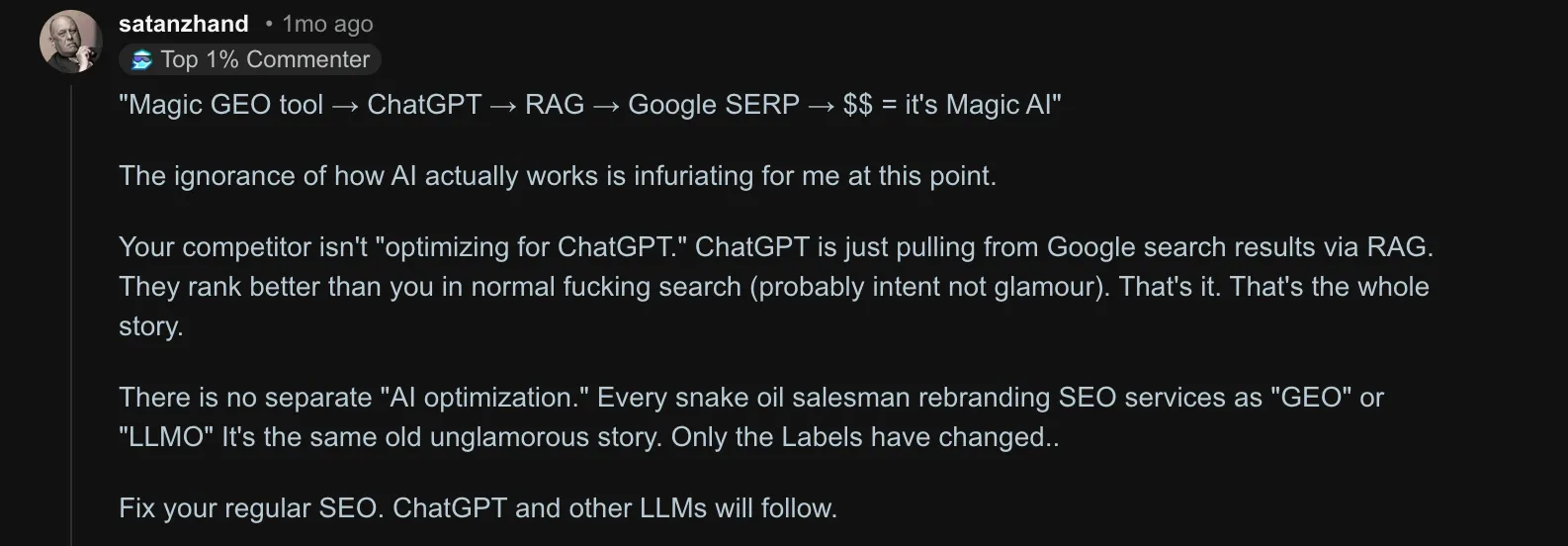
Back to business, if you’re feeling FOMO from every “Top 50 AI SEO tools” list, you can relax. Most experienced SEOs are quietly running on a lean stack, not hoarding every shiny new app.
How to choose the best AI SEO tools for your team
Here’s a simple framework to keep you from buying yet another tool you never log into.
1. Fit first, features second
The important question to ask is “Does this plug into my existing stack?”.
- GSC / GA / Looker Studio
- Your CMS (WordPress, Webflow, custom, etc.)
- Your current SEO suite or rank tracker
If getting data in or out is painful, that tool will quietly die in month two.
2. Data quality & transparency
For tools doing AI-driven keyword research or PAA scraping, ask the following questions.
- Where do they get SERP/PAA data from?
- How often is it updated?
- Is it using live SERP data or stale internal datasets?
You don’t need perfection, but you do need to know what you’re trusting.
3. Control & guardrails
Look for the following:
- Customizable briefs and templates
- Tone and style controls
- Limits on keyword density / spammy recommendations
- Easy exports (Docs, CMS, CSV, API)
If a tool tries to lock everything inside its own editor, that’s friction your writers will resent.
4. Pricing vs actual usage
AI SEO tools love credit systems and per-seat pricing. So, check the following:
- How many briefs, articles, or reports do you really create per month?
- Is it per-user, per-workspace, or per-output?
- Can you clearly tie cost to time saved or traffic gained?
5. Support & roadmap
AI search is evolving fast. Look for:
- Evidence of active development (recent changelog, docs, blog)
- Support that understands AI Overviews/LLM SEO, not just “10 blue links” SEO
- A roadmap that includes SERP changes, AI Overview tracking, etc.

Quick checklist before you buy your next AI SEO tool
Here is a bunch of questions that you must ask before the purchase
- Does this integrate with my core analytics/SEO tools?
- Do I know where its data comes from?
- Can I customize outputs and keep the brand voice intact?
- Will at least one person on my team use this weekly?
- Can I justify the cost with a clear “this saves X hours or grows Y traffic” story?
If you can’t tick most of these, keep looking.
Example AI SEO stacks (by use-case)
Let’s turn all of this into concrete “starter stacks.”
1. Solo blogger/creator
- Goal: move faster without losing authenticity.
- Research & clustering: Mangools (KWFinder) + Keyword Insights
- Content optimization: Surfer or Clearscope (pick one)
- Writing: ChatGPT + Jasper for drafts and rewrites
- Basic tracking: GSC + a simple rank tracker
That gives you AI tools for seo without overwhelming you with dashboards.
2. In-house SEO team
- Goal: collaborate across content, dev, and leadership.
- Core suite: Semrush for keyword research, site audit, and competitor intel
- Content optimization: Surfer or Clearscope for briefs and on-page
- Technical automation: Alli AI for on-page rules and internal link suggestions
- Reporting: Whatagraph for cross-channel SEO reports & dashboards
Here, the focus is on shared visibility and making it easier to prioritize sprints and content roadmaps.
3. Agency
- Goal: keep delivery scalable and client-friendly.
- Research & clustering: Keyword Insights + AlsoAsked for topic maps and FAQ ideas
- Content optimization: Surfer or Clearscope (standardized across writers)
- Technical & automation: Alli AI or OTTO to roll out changes across many client sites
- Reporting: Whatagraph for white-label-friendly, automated reports
Pair this with strong internal SOPs so AI outputs are always human-reviewed before clients ever see them.
Risks, limitations, and best practices while using AI SEO tools
Let’s talk about the parts people regret.
Risks & limitations
1. Generic content everywhere
If you follow tool recommendations blindly, you end up with the same headings, entities, and examples as everyone else. That’s a fast track to “meh” content.
2. Over-optimization
Chasing a content score can push you into keyword stuffing, awkward headings, and bloated, unhelpful articles. Google’s helpful content and spam updates are not kind to that.
3. E-E-A-T & brand voice still matter
AI doesn’t know your internal data, your customer stories, or your lived experience. It also happily hallucinates facts.
Best practices
To stay on the right side of things:
- Use AI to shortlist ideas and structure (outlines, clusters, FAQs)
- Layer in proprietary insights, data, screenshots, and examples
- Keep a “do not automate” list (YMYL content, thought leadership, product pages)
- Treat AI scores as signals, not goals
- Regularly compare AI-optimized content against real performance and adjust
In short: Let AI do the repetitive lifting; keep humans in charge of originality and truth.
So… are AI SEO tools worth it?
Short answer..YES
But
AI SEO tools aren’t going to “do SEO” for you… but they can make a big, very real difference when you use them on your terms, not theirs.
The win isn’t in stacking 15 tools. It’s in knowing where you’re slow, where you’re guessing, and where AI can take the heavy lifting off your plate like research, clustering, briefs, audits, reporting, so your team can focus on thinking, not tab-wrangling.
So start small, pick 1–2 tools per stage, plug them into your existing workflow, and track what actually changes (time saved, content shipped, traffic gained).
Treat AI as your copilot, keep humans in charge of quality and strategy, and you’ll move from
“AI SEO tools = hype” to “AI SEO tools = unfair advantage” a lot faster than you think.
FAQs on AI SEO tools
1. What are AI SEO tools, and how are they different from traditional SEO tools?
AI SEO tools use machine learning and natural language processing to analyze search data, content, and technical issues and then suggest what to do next.
Traditional tools mainly report what’s happening (keywords, rankings, errors), while AI tools try to interpret patterns and generate ideas, clusters, or drafts for you.
2. What are the best AI SEO tools to use right now (for small businesses, agencies, or WordPress sites)?
There’s no single ‘best’ tool, but most winning stacks include one for keyword research/clustering, one for content optimization, and one for reporting.
Small businesses often favour simple, affordable all-in-ones; agencies lean towards tools with collaboration, white-label reporting, and automation.
3. Can SEO be done by AI, or will AI SEO tools replace human SEOs and content writers?
AI can handle a lot of the grunt work: clustering keywords, generating outlines, suggesting internal links, and even drafting rough content. But it can’t replace strategy, brand voice, deep subject expertise, or the judgment needed to decide what actually deserves to rank.
So no, it won’t replace SEOs or writers; it just changes their job from “do everything” to “direct and refine.”
4. Is AI-generated content safe for SEO, or can using AI SEO tools hurt my Google rankings and E-E-A-T?
AI-generated content is not automatically bad for SEO; what matters is whether it’s helpful, accurate, and genuinely valuable to users.
If you publish raw AI output that’s generic, spammy, or wrong, you absolutely can hurt your rankings and perceived E-E-A-T.
Use AI for drafts and structure, then add human editing, original insight, and fact-checking before anything goes live.
5. How do I choose the right AI SEO tools and build a simple AI SEO stack that actually fits my goals and budget?
Start from your workflow, not the tool. Here is what you have to do:
- List where you’re losing the most time (research, briefs, writing, audits, reporting).
- Then pick one tool per major stage, checking for data quality, integrations (GSC/GA/CMS), and pricing that matches how often you’ll really use it.
If you can’t explain how a tool will save hours or help ship better content, it probably doesn’t belong in your stack.


.svg)